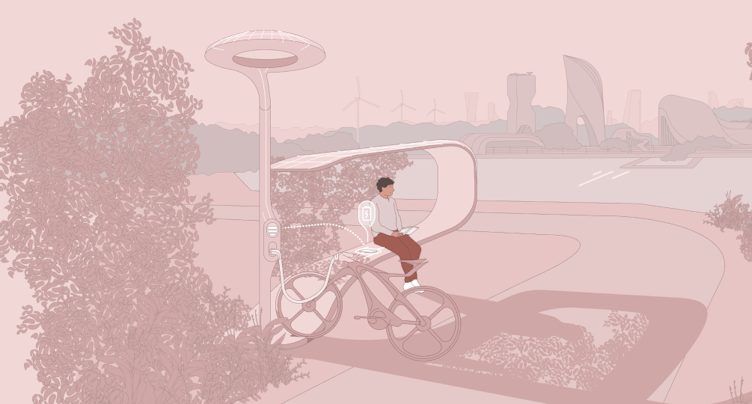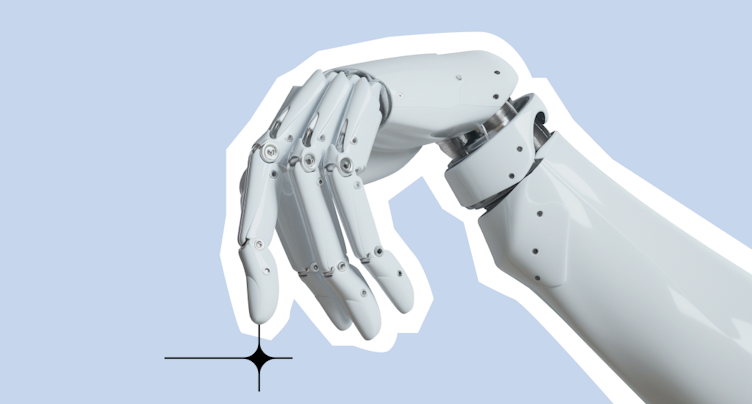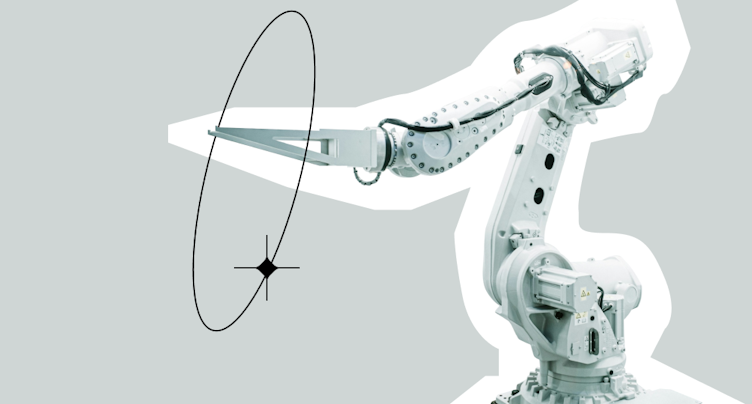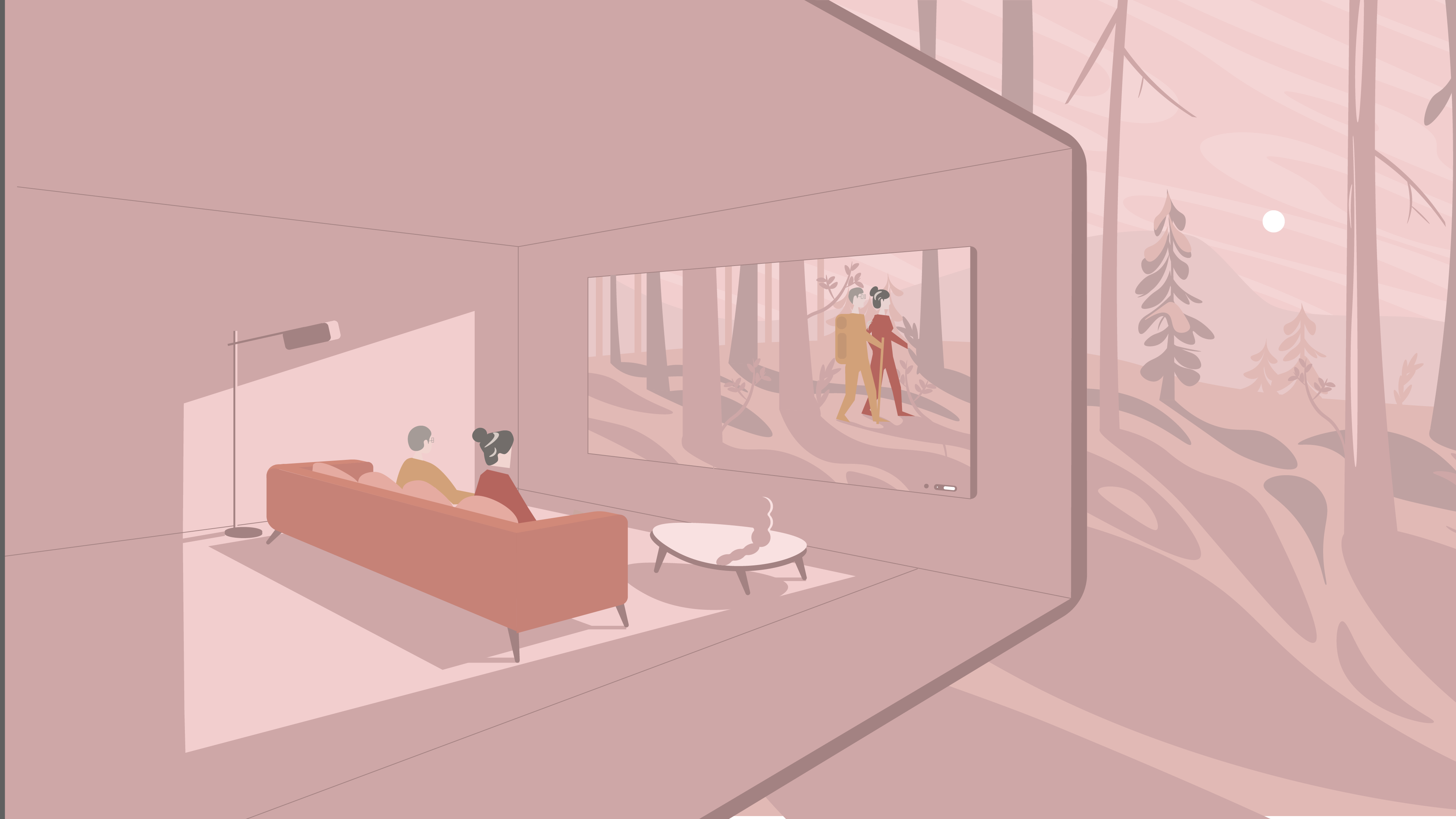
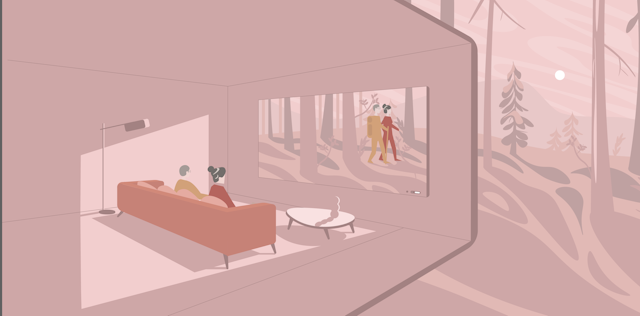
Healthcare: the designated torchbearer of digital innovation
Most developed nations spend over 10% of their yearly GDP on health-related expenditures. No wonder that the sector is considered the next big frontier of digitalisation. Customer expectations do not recognise boundaries between industries and as “software eats the world” in other areas of life (entertainment, commerce, finance… and now even education and administration are waking from their slumber), healthcare is placed under tremendous pressure to reimagine itself in a connected world. It’s not surprising that the industry all around the globe works hard to create a holistic digital experience to patients that is on par with expectations transported from other, digitally more mature areas (real-time information, booking systems, self-care functions, etc.).
Industries going through digital transformation right now have a much easier time to reform their operations. Reinventing the wheel became unnecessary here: the digital space has already established its best-practices and expectations. We have no doubt that the above goals will be met during the next five years, abiding the law of gravity centred around customer demand. Will it be easy? By no means, but it will be quicker than expected – and inevitable. Gravity rarely fails to work.
Even so, we think that the healthcare industry is capable of much more than just catching up with the leaders of the digital revolution.
Health is such a fundamental source of human happiness that we consider it the single most important area for innovation. It should, and we believe in many areas it will pioneer the symbiosis of technology and humans.
“We are all cyborgs now,” claims Amber Case, who researches the way people and machines interact and evolve together. Nonsense? If we think about all the ways our mobile phone augments or replaces our natural human abilities – memory, access to information, communication, productivity – it suddenly becomes hard to argue with her. Wearable technology is still in its infancy but it’s already clear that health and well-being are the most exciting areas where it can enrich our daily lives. Now it’s up to the leading minds of the healthcare industry to define how we turn these opportunities into a driving force for longer and more fulfilling lives.
Change behaviours to change lives
In recent years Supercharge’s design team has been helping healthcare experts to turn their vision of the future into products that change lives. We learnt that for introducing radical changes in one’s health regime, good health practitioners are often not enough on their own. They can point out the path, but it’s the patient who has to walk it. In prevention and treatment alike, results are profoundly affected by patient behaviour. This is especially true as focus shifts from treatment to prevention, and boundaries between well-being, fitness and healthcare become ever more blurred. This is the trend that prompted us to dedicate this report to the topic of influencing behaviour through digital products.
While we attempted to provide a glimpse into significant results of behavioural science, ultimately what we wanted was to give you a hefty collection of practical techniques that you can apply to help users make better choices and adopt healthier habits.
Our report covers three extensive topics. First, we talk about the frail nature of human decision-making and show how Nudges may remedy our built-in biases. Then we discuss how to help users adopt new habits to improve the quality of their lives. Finally, we examine how to leverage one of the most ancient sources of joy – games – to keep up motivation. We believe that these three topics are deeply interconnected and together they offer a wide array of tools. With these in hand, it’s possible to create effective digital products that are able to solve unique problems.
Talking about behavioural change has never been more relevant than right before the start of a new year. After all, ‘tis the season for big resolutions to live a healthier, more fulfilling life.
Navigate to the 3 parts of the report:
Part I.
Good choices lead to a healthier life: how to help people make them?
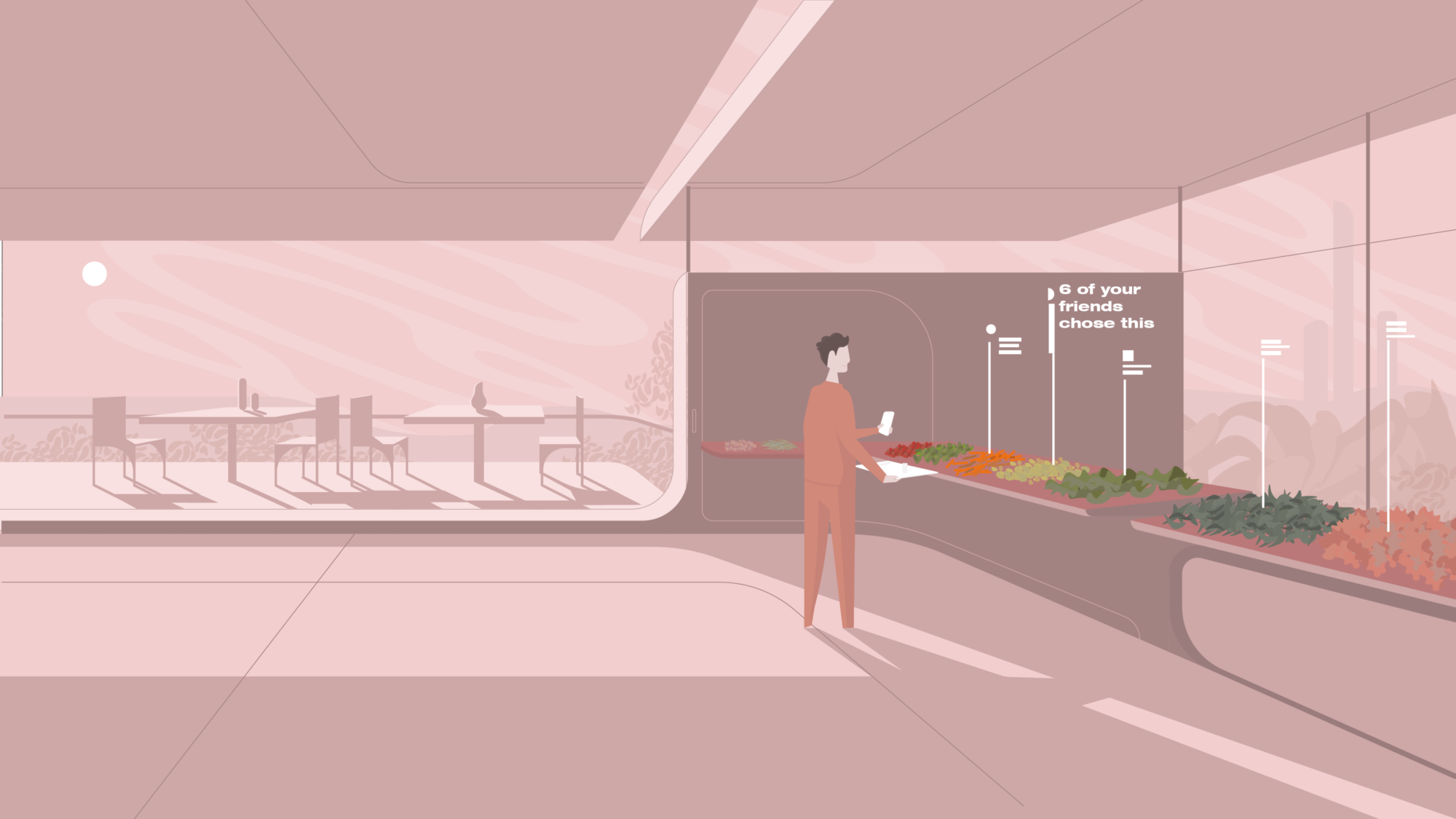
We exert control over our lives by making decisions. But the frailness of the human mind often leads to decisions that yield sub-optimal outcomes – this is especially true in the field of health, where our instinctive choices are rarely the best, and where anxieties often overcome rationality. The first part of our report will discuss how to design choices that are able to subconsciously influence people to make smarter decisions.
Why do people need a little push towards smarter choices?
Nudges are guidances built into a design that subtly steer people toward the decision that’s most likely to be beneficial for them. They gently nudge people to make the right choice: putting the salad at eye-level and the cookies somewhere out of sight is a Nudge toward healthy eating.
The concept was born out of the conviction of behavioural science that people often have a hard time making sound decisions when facing complex problems: they simply fall prey to subconscious biases and lapses of judgment. The goal is to deliberately deploy the same hidden mechanism to “trick” the mind into selecting smarter options. The design relying on such calculated decision points is called choice architecture. Choice architecture is especially important as it’s almost impossible to design a choice situation where nothing influences the decision (even the order of the options does!). If we don’t plan these crossroads carefully, we leave this effect up to chance.
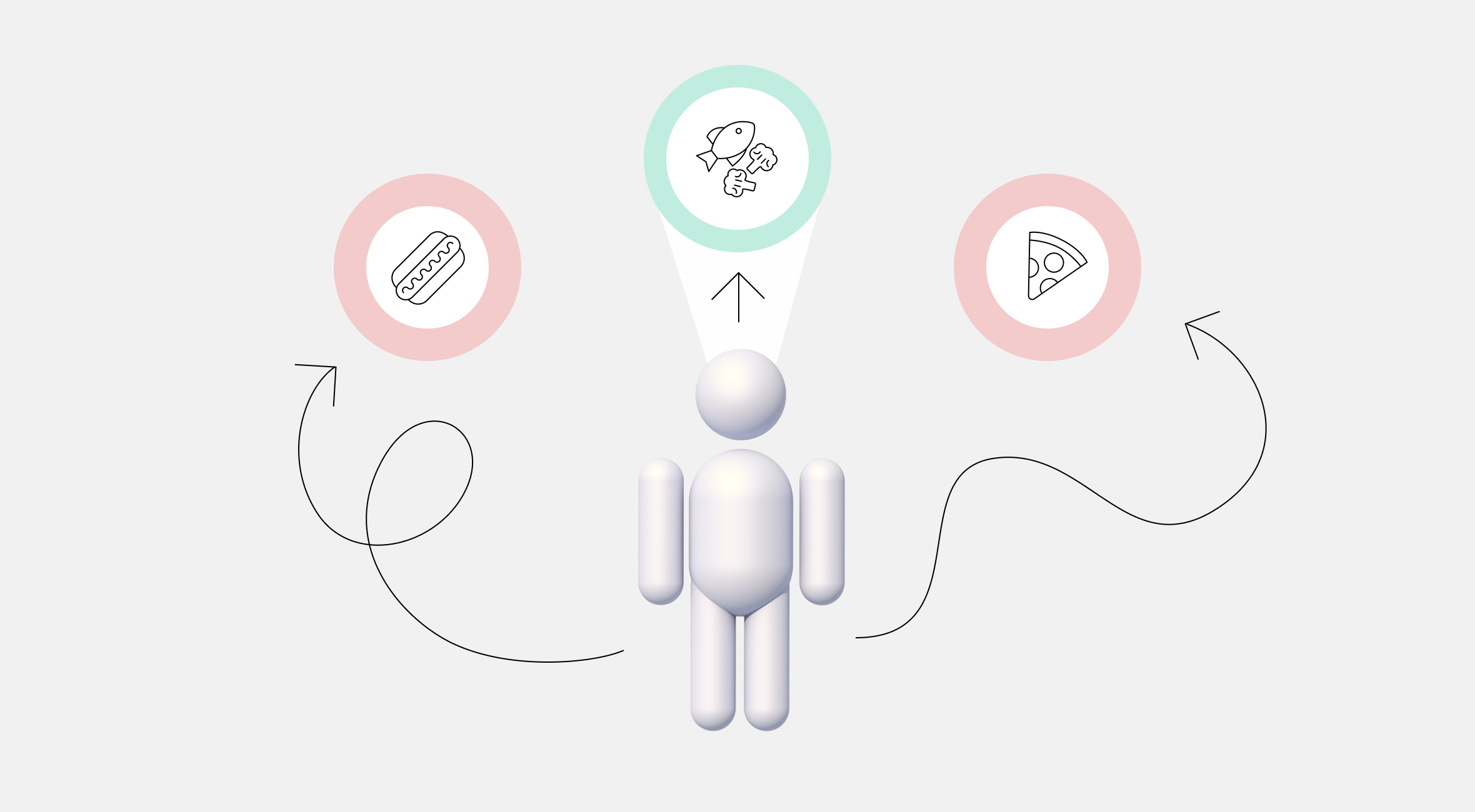
The premise of Nudges is never to actually force decisions on people. The idea of influencing people’s behaviour without restricting their freedom of choice is called libertarian paternalism. In this report, we only deal with Nudges that genuinely promote the well-being of customers, but obviously the concept can be used for less altruistic goals too (just think of bakeries blowing the seducing scent of freshly baked pastries to the street to lure in hungry customers). The concept of Nudges has been actively used in the Netherlands in public policies since the 2008 financial crisis. While it’s considered a light form of manipulation, a “soft-touch” pushing toward more beneficial behaviour, it’s generally accepted even coming from public organisations.
Nudges presuppose that humans are rarely fully rational in their decision-making, so first we will address this aspect.
The rational decision-maker is a myth
Humans like to think of themselves as completely independent agents, always making decisions that best serve their goals and “maximise utility”. At the dawn of social sciences, economists portrayed the Homo sapiens precisely in this fashion, and all basic economic models took it for granted that people are entirely rational. If you ever felt compelled to take a second cookie from a bowl simply because it was staring at you from the table (even though you knew that you’d be having a delicious lunch within a short time), you should know that the model of perfect rationality doesn’t hold water.
Classic economics created models around a non-existing species, the stern Homo economicus (“Econ” for short), who never errs in judgement. The guy is great, a paragon of logic – but when designing products, we have to cater to actual, flesh and blood humans, not to fantasies.
The prehistoric brain confused in the urban jungle
Our magnificent brain is still the same hardware that we inherited from our prehistoric ancestors. Gorging on carbohydrates always feels like a seducing option, because this decision made perfect sense in a prehistoric world, where the next meal might have been weeks away (and where obesity wasn’t anyone’s worry). While brain plasticity is probably the most defining feature of the human race, our body and mind clearly come with a vast amount of genetically hard-wired behaviours: biases, assumptions and shortcuts (and craving for cookies). It’s a good thing too, because the mind-boggling complexity of today’s world is only manageable if most of our decisions can be calculated invisibly in the hidden depths of our nervous system
The hidden powerhouse that is often too quick to answer
Science debunked the idea of this mystical race of ever-logical thinkers and uncovered a secret world under the thin veneer of conscious thinking. In his seminal book Thinking Fast and Slow, Nobel Laureate Daniel Kahnemann offers a framework of two radically different modes of thought that guide people’s decision-making (we have changed the names of the systems for easier understanding). “Automatic System” is the blazing-fast, intuitive thinking, while “Analytical System” marks our analytical thought process that relies on logic and deliberation.
We like to think that most of the time it’s the Analytical System who occupies our mind’s pilot seat, but research shows that it’s actually the other way around.
Dedicating our focused attention to decision-making requires energy, so our brain rather prefers to delegate it to the seemingly effortless intuitive thinking.
Our Automatic System usually spits out results with unparalleled speed based on memories of previously successful solutions and myriads of heuristics (some of them learnt, others hard-wired by evolution). But it often does a hasty work that results in severe lapses in judgement. It tends to reduce convoluted challenges to simpler problems, many times losing important information on the way. In general, the more complex the issue – and the further it lies from the prehistoric challenges our brain had evolved to solve – the more likely our intuition will come up with the wrong solution.
The difficulty starts when (following our natural inclination) we use the Automatic System to solve problems best suited to the Analytical System. The main inspiration for Kahneman and Amos Tversky’s research came from their experience of observing expert statisticians answer basic statistical questions erroneously because the solution seemed simple enough to just shoot from the hip without applying analytical thinking.
How to use Nudges to remedy typical errors of judgment
Thaler and Sunstein, the fathers of the Nudge theory in their homonymous book showcase the typical reasons why human judgment fails. Now we will discuss the ones that are most relevant in the field of healthcare and expand the original theory with possible applications in digital product design.
Heuristics and biases: mental shortcuts that simplify a messy reality
Tversky and Kahneman coined the term cognitive biases: our Automatic System takes mental shortcuts to solve problems, which result in systematic error of judgment, and produces irrational decisions. In order to successfully implement Nudges, we need to know about possible “thinking traps” and turn them to our advantage.
Anchoring, or the dominance of the first information: We need a starting point to begin our thought process, and we are quick to use the first information we receive or remember as a springboard for our subsequent ideas. If the asking price of a home is €500,000, average buyers rarely try to start the negotiation from €100,000. That’s why the expensive cars are placed at the front of the salon: after you see those, everything else will seem cheap in comparison. Anchors aren’t necessarily numbers: if the first information you hear about a doctor is that his last operation wasn’t successful, it will be hard to restore your confidence in his skills – even though he might have the best track record in the whole city!
- Lead with your strongest: Be conscious that the first information you give to your customer will hold extra importance for their decisions. Lead with the one that will most likely nudge them to the right direction. Build the narrative of your digital journey on a strong first impression and make sure that everything that follows reinforces it.
Availability, or jumping from subjective experiences to statistics: The availability bias simply means that we tend to assess the likelihood of an event based on how readily examples of it pop into our mind. What do you think, what’s the risk of being attacked by a shark in Australia? If you read a few shocking articles about such cases you probably think it’s quite high. In reality, cycling in Australia is 50 times more dangerous than swimming in the sea. Your guesstimate will also depend on how much the given event captivates your imagination or frightens you (that’s why plane crashes are thought to happen more often than they actually do), and how much time has passed since you last heard about it happening.
- Don’t be afraid to be dramatic: When you want to make sure that people take a health risk seriously, use tools that evoke emotion. Simple statistics about heart attacks might be forgotten in a second, while a terrifying video will burn into the viewer’s memory and bump up the perceived risk of the thing in question. (For example, governments use this strategy on cigarette packages.) After the initial “shock”, regular reminders will be enough to keep up the sense of importance (e.g., push notifications).
Overconfidence, or statistics are for losers: When people judge their chances for success, they tend to think that statistics won’t apply to them. Their marriage will never end in divorce (50% of them does), their new business won’t fail (more than 50% does). They even think they will succeed in the restaurant business (80% of restaurants go bust in the first five years!). And this is not because we are totally oblivious to statistics: when surveyed about average chances, people usually nail these numbers quite well. Even so, they estimate the probability of their own success extremely high. The reasoning? Mostly just “I am me, and they are not.” This has a definite upside: without this unfounded optimism, there would be no new restaurants to sample. Evolution seemingly prefers those who take initiative, even when things look gloomy.
- Make risks feel personal: This type of Nudge is extremely relevant for healthcare products, as customer overconfidence unfortunately also applies to risk taking. People who engage in harmful habits (smoking, unprotected sex, a diet consisting of bacon and cheddar cheese…) are usually very well aware of the risks associated with their activity. They just think the statistics don’t apply to them and they are magically immune to harm. The solution? Focus on subjective experiences (see availability bias) instead of statistics. Numbers (other than prices) leave people unmoved.
Gains and losses, or we like to keep what we have: The average person is much more afraid of losing something than excited about gaining the very same thing. On average, we are willing to risk losing €100 if we have the chance of winning €200, and this 2:1 ratio in favour of loss aversion seems to be a constant value in different experiments. Obviously, in terms of payoffs, this is irrational – but we have probably mentioned enough how the human brain often couldn’t care less about mathematical calculations.
- A little scare can tip decisions: While modern marketing communication usually advocates concentrating on the value and on the upside, we shouldn’t forget the power of loss aversion. To persuade people to follow the “smart path” we have to highlight the possible losses that can occur if they do otherwise. Again, let’s not forget: highlighting doesn’t mean showcasing risk statistics. It means concretising the possible loss in a way that captivates users’ imagination. It’s worth noting that it takes a careful design process to leverage this principle without causing unnecessary anxieties – especially in a field already stressful enough for patients.
Status Quo Bias, or we are creatures of comfort: It simply takes more effort to change something than to leave it as it is. It needs more deliberation, brings in an element of unpredictability (someone mentioned possible losses?), and occasionally involves some actual legwork as well. These all require extra energy, and our brain – aimed to preserve resources – will try to avoid that. Inertia is a great power to reckon with, and designers around the world have successfully recognised this. Freemium apps lure you into providing your credit card details by offering a week or a month of free trial in the hope that most people will just forget to cancel their membership anyway. Reality is even harsher: often they don’t actually forget it, but they’d rather pay than put extra effort into changing the status quo.
- Include defaults that create the most benefit: There is significant advantage to be gained from this powerful tendency by designing smartly set defaults. No matter whether you are working on a digital product or a policy, people will likely just go with the default options. In countries where organ donation in case of accidental death works on an opt-in basis only 10-15% actually register for it, while in countries where it works on an opt-out basis more than 90% give permission for it. That’s a massive difference – and you can expect similar results in your products as well.The Netherlands has introduced new regulations this summer to switch to a “no-objection system”. Those who fail to register their choice will be placed into the “no-objection” category, which means their family members will have the final say about their organs. This is a very sensitive question, but the new solution seems to be a smart compromise between the opt-in/opt-out systems. Of course, keeping certain choices opt-in is legally mandated (like newsletter subscription), but in many cases the decision lies with the product’s designer, and the option to nudge people in the right direction is there for the taking.
Framing, or presentation is all that matters: Framing essentially means that the exact same information can have a very different effect on your decisions depending on how it’s presented to you. This bias is so powerful that even experts fall for it sometimes. Test it for yourself: a “70% fat-free” yoghurt sounds much more attractive than the “30% fat” version, even though these are obviously the same. “After the operation 90 out of 100 patients are able to keep their tooth in the long run” communicates the same chances as “10 out 100 patients lose their tooth within three months of the operation.” So, while the first one sounds very reassuring, the second would definitely alarm people and many would change their minds about undergoing the procedure. The underlying reason is the brain’s laziness (erm, energy conservation!) – the Analytical System is rarely activated to check out these statements with a bit more care.
- How you frame possible choices has a tremendous effect on what people will decide. If you want a choice to look more appealing, communicate it in a way that evokes positive images. If you want to steer away people, make it look riskier. You can do all this simply by phrasing the truth differently. Of course, marketers have long known that the way of saying things can significantly influence consumer choices (hence McCANN’s famous tagline: “Truth well told”), but behavioural science shows that framing has a powerful effect even in very serious, seemingly data-based decisions too. Make sure you consider how your presentation of an alternative will affect customer emotions. Even when you’d expect the ensuing decision to be a very analytical, data-based one, you might find that no one actually bothers to look at the math.
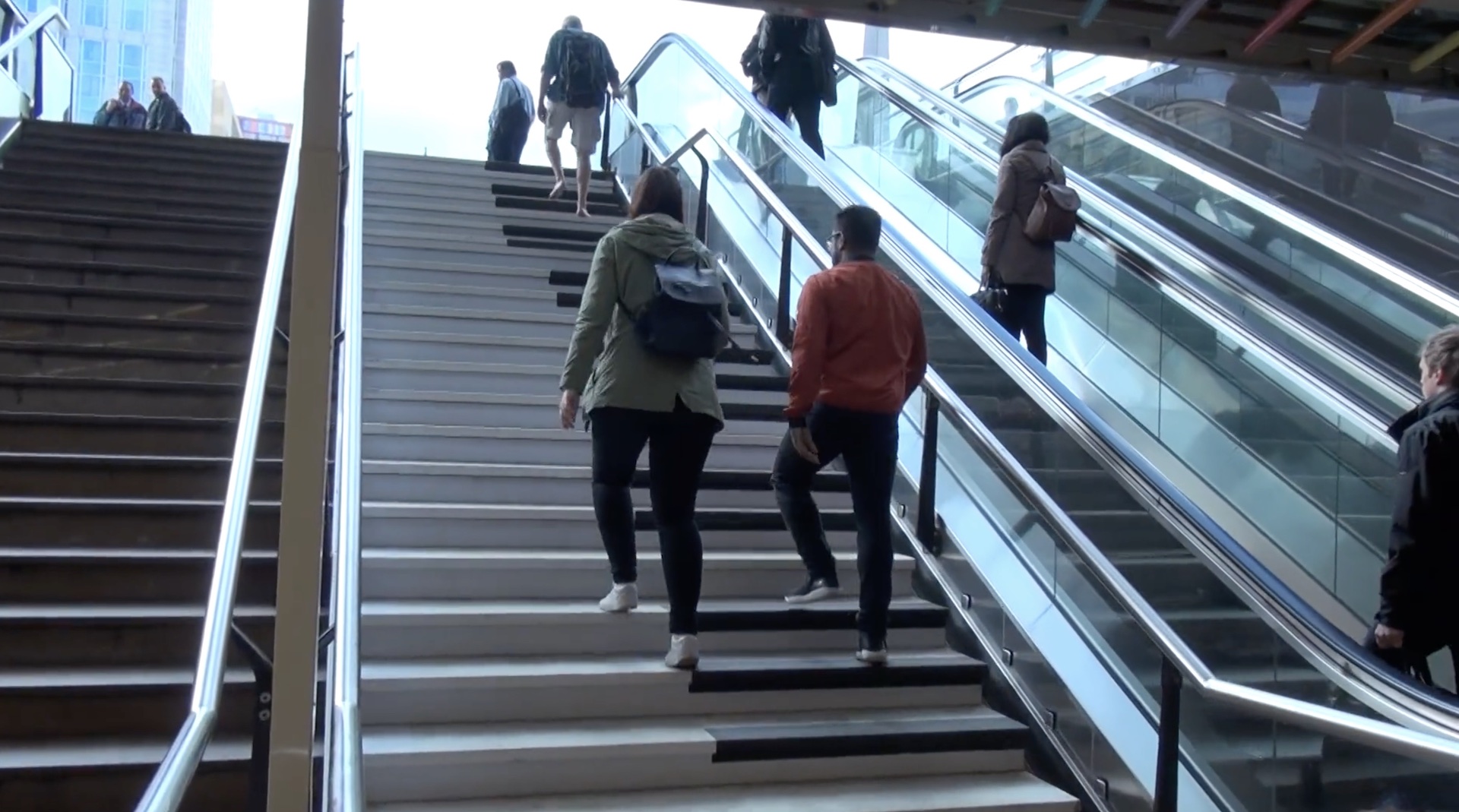
Mindlessness: running on cruise control
There are occasions when we instantly realise the need for thoughtful decision-making and our Analytical System quickly grabs the wheel to take control (no one tries to solve a quadratic equation based on intuition).
But in several cases we just do things on autopilot and deliberate consideration never actually happens (most micro-decisions in a day are made this way, bringing totally satisfactory results).
This autopilot state is called mindlessness.
Mindlessness only becomes a problem when we don’t recognise that a situation would require more careful consideration and the decision we make with our Automatic System results in suboptimal choices.
How to work with or against mindlessness: We can’t expect that people will engage with our product in a very mindful way. While planning a product, you can safely assume that people won’t care much about it and just want to get the benefits – with as little thinking as possible. They will click through without reading the instructions and glance over important information.
- Make sure that anything they’ve carelessly dismissed can be found and checked again, preferably in the context where it’s needed (explain a function right when it is used, not during onboarding…).
- Expect errors coming from lack of attention and help people recover from them easily. It’s not because users are stupid; they just don’t care.
- Let the user interface (UI) do the heavy lifting. The right UI can effectively guide users who click around in a mindless state by utilising signifiers and a well-crafted information architecture, as well as leveraging existing mental models and biases (like the ones outlined in this report). So, a good UI – created by skilled Interaction Design experts and supported by proper usability testing – in itself can nudge inattentive users in the right direction.
- An interface with high usability builds upon affordances, signifiers, constraints, mappings, and it provides clear feedback. It also takes into account existing mental models of its target users – the nuts and bolts of Interaction Design. Better usability should result in easier operation.
- Shake up people at important decisions: make sure you grab users’ attention when it really matters. Bold colours, large objects and movement (hello animations!) can help people become conscious of the fact that this decision requires actual attention from them.
- People often forget things they wanted to do: reminders and notifications are efficient tools to help them stay on course.
The management consultancy company BCG has implemented an interesting Nudge challenging mindlessness, as part of their “Making Time Off Predictable—and Required” programme. When employees send emails outside working hours, a software reminds them that their colleague is resting at the moment – a fact they definitely knew, but weren’t mindfully considering. (They can decide to postpone sending the email to the next working day or stick with sending it anyway.)
Temptation: when the spirit is willing, but the flesh is weak
Sometimes the human mind experiences open hostility between instincts and rational thinking: temptation and losing self-control are manifestations of this. “I really want to lose weight but I just never feel like going to the gym…” “I know I shouldn’t have eaten all those marshmallows, now I feel sick…” Such sentences are everyday fixtures in our life.
A battle of epic proportions happens in each of us, when our ancient propensities clash with our consciously set goals. Most of our instincts are essential to keep us alive and happy, it just happens that in our modern world some of them became pretty lousy advisors.
Self-control varies from person to person, but even the same person’s ability to control their impulses fluctuates: their energy levels and the context they are in both influence it. If we are hungry when we get home, we might still resist eating sweets, but if our spouse just baked a cake that smells heavenly, the same decision gets significantly harder. Research also shows that exercising willpower to overcome our instincts requires a considerable amount of energy. If we are tired, we have a harder time staying on course.
Help people stay on course: Most people are aware of temptations and try to manage them to some extent. You avoid cake shops when you are on a diet. You set up multiple alarms because you know that you’ll just hit snooze the first couple of times. We call the self that has great ambitions for the future the “Planner” and the one acting under the influence of temptations the “Doer”. So, the job is to design features that will help the Doer stay faithful to the mission set by the Planner.
The most help is needed with “Costs Now, Benefits Later” situations. Self-control issues predictably arise when people need to invest energy now to enjoy some benefits in the far future. Adherence to blood pressure medications is hard because taking pills every day requires dedication now, while the risk of a heart attack seems really far away. Eating salad and exercising requires forgoing your crisps and Netflix today, but the slimmer, healthier you still won’t be ready for a while.
- One way to help with this conundrum is to facilitate habit building. Once something becomes automatic, users need much less self-control to keep doing it as their Automatic System takes over. This is a powerful tool, and in this report we dedicate a whole chapter to implementing products that support habit formation.
- Another good idea is to help turn the formula around: sweeten the costs with some immediate rewards. Read our gamification chapter for ideas on how to do so.
We are social animals: the choices of others influence ours
The human brain evolved to this level of sophistication mostly to facilitate social interactions with other people. We dedicate an immense amount of energy to obsess over what others might think, and to run mental simulations about how they would respond to our possible actions. Social life is a gigantic chess game with endless possibilities, and effectively playing it requires a marvellous processor: our brain. Social relations are so important to us that when our basic biological needs are met, most of our higher-level goals and motivations revolve around these. And we don’t just affect each other on a conscious level: we influence others (and are being influenced) constantly without our knowledge. In product design these unconscious social effects can be leveraged with great results.
Conformity, or following the herd (even if it’s falling off the cliff): In a famous experiment participants were asked to compare the length of sticks. In 20-40% of the cases a group of random strangers (research assistants in disguise) were able to change a person’s mind about their selection, even though their own senses told them otherwise. It was enough that the subject heard them unanimously voting for another option.
If enough people say something, we tend to agree, even if it invalidates our own perception. Imagine how easily we succumb to conformity when talking about something more subjective... (Hint: whole societies agree about fully arbitrary ideas.)
- Show that everyone else has chosen to be smart: We can utilise people’s tendency to conform to steer them toward smarter decisions with a little digital peer pressure.
- Showing statistics can work (a badge reading: “80% of patients chose this”), but an even stronger way to promote a direction is to point out acquaintances who already chose to go with that particular thing (using social networks). Real-life experiments prove that the simple act of making people aware that complying is the norm effectively sways them toward actually doing it. For example, a message reading “92% of our users never skip a day in measuring their blood pressure!” can create the right type of pressure here.
- Telling people that they are doing better than others usually motivates them to preserve their position (“You belong in the fittest 8%!”). In the same vein, disclosing that they lag behind the norm urges them to catch up (“You have exercised less than 90% of our users. Let us help you catch up!”).
Complex decisions are hard decisions: our information-processing abilities and our patience are both limited
Our brain gets the most confused when it has to solve really complex dilemmas. The complexity increases with the number of alternatives and factors that should be taken into consideration. It’s easy to pick one out of two painkillers if they both have the same qualities except one of them lasts longer and is a bit more expensive. It’s a decision that can be easily imagined in terms of a subjective experience: “I have less money in my pocket, but my pain is gone for a longer time”.
However, when you need to pick from 15 different painkillers and you are also watching out for a multitude of factors (strength, effectivity when it comes to different kind of pain sources, possible addictiveness and side-effects, brand allure, what my friend told me about it, etc.) the decision becomes mind-boggling… So, you tend to just go with your intuition. Without trying to write a comprehensive summary on the psychology of decision-making, we want to highlight a few situations here when customers actually have a lower chance of making a good decision. In other words: they could really benefit from the right Nudges.
Too many choices: In a market economy we take it for granted that it’s good for customers to have as many choices as possible.
However, experiments show that it's not really true: we are happiest with a few well-structured choices. We usually don’t like it if one option is forced upon us, but too many choices can lead to decision paralysis.
Has it ever happened to you that you wasted 15 minutes in a supermarket baffled by the bewildering number of fabric softeners? That’s why some brands are so successful – they transform a hopelessly complex analytical decision into a simple, emotional one. People follow different decision-making strategies: Maximisers want to make sure they pick the best possible solution and they are anxious about missing out on something that might be even better. No wonder they are especially paralised by a wide array of alternatives! Those who are at the Satisficer end of the spectrum have a somewhat easier time, as they are fine with settling for a solution if it’s “good enough”
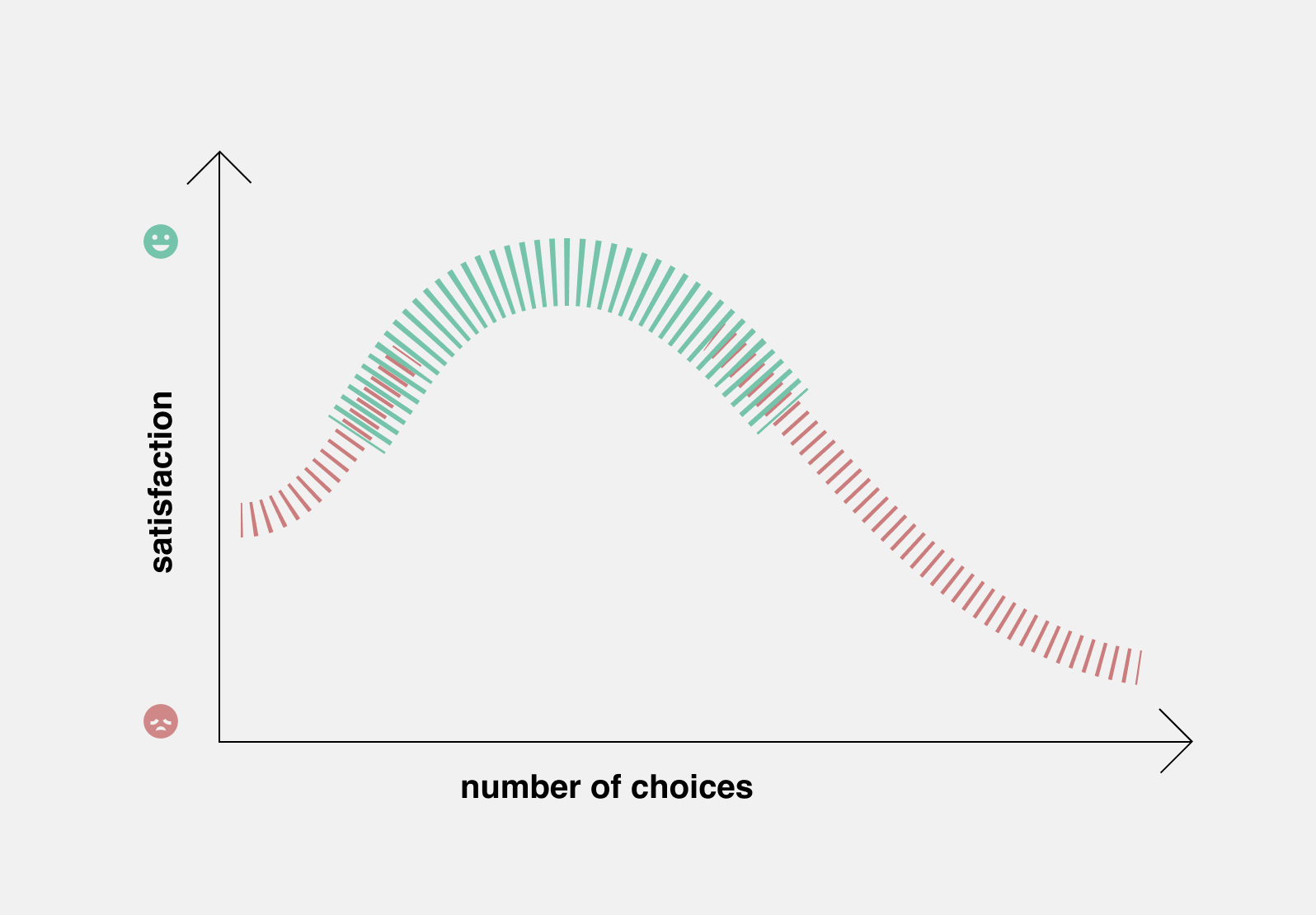
- How to work with this? In a complex world where people are already overwhelmed with information, simplicity is the pinnacle of modern digital product design. More is not always better: aim to cut down the number of possible choices to simplify decisions. This is a true balancing act as people will have less opportunity to customise your solution – but designers usually grossly overestimate the amount of customisation people actually utilise. Simplifying decisions isn’t just good for the customers, it’s also profitable: in a famous real-life experiment consumers faced with too large a variety of jam flavours started to buy less of it.
Automatic simplification brought on by too many choices: Beyond a point of complexity only a well-trained analyst could produce a fully rational decision.
If there are too many factors to take into account, people will just simplify the decision.
They start defining arbitrary cut-off points (“I’m only going to see a doctor in my neighbourhood.”) and pick a few subjective factors to base their decisions on (“I’ll only check out a doctor’s customer rating and their distance from my home”). When they managed to filter out most of the alternatives, they will examine the few ones that made the cut in more detail. This process is obviously too intuitive and leaves much to chance: the most beneficial choice could be easily eliminated on the way.
Help find the right choices: You can help people make complex decisions using multiple techniques. Let’s check out some of them:
- Recommendation: You can recommend a solution and many will just take it (the more perplexed users are, the more they will lean on this function). What you base your recommendation on can obviously vary. One end of the spectrum is offering a few expert recommendations/crowd pleasers, which might not be the perfect fit for anyone but will be good enough for everyone. The other end would be data-driven recommendations, tailor-made for the given user (this solution can make sense if you have a massive product or service directory). Of course, this latter only works if you possess enough data and know enough about your customers’ context and needs. Recommended options are very strong Nudges that can make a user’s life much easier.
- Help connect choices to expected outcomes and future experiences: People don’t want an app with over 800 vitamin-rich recipes, they want to make sure they will have easy cooking instructions for every evening that offer enough variety and keep the family healthy. Is 800 enough for that? Would offering 1200 be better? If you say your app contains a new dish idea for every evening for more than two years, the information will be much easier to comprehend and a lot more relatable. In some cases (like with different insurance policies) it’s much harder to summarise the outcomes this way, but it is worth the effort: a paralysing data set and policy pile will be instantly transformed into imaginable human experiences to choose from. Obviously, the way you frame these experiences will also create ample opportunities to nudge people toward the more beneficial options.
- How you organise data and enable filtering is a Nudge in itself: The way you enable people to filter possible choices will influence what kind of factors they’ll consider. Let’s say you have a website for browsing doctors: if you prominently feature a filter for visit fee and years of experience, most people will accept that these are the main factors they should use to shortlist possible candidates. Yet, if you highlight customer ratings and availability, most users will arrive to a different set of finalists. Some customers will always put the effort into setting up their own criteria system, but you can safely expect that the majority will just go with the flow. Your job is to make sure this flow brings them to the most beneficial choices.
Part II.
Habit building with digital products: decisions on autopilot
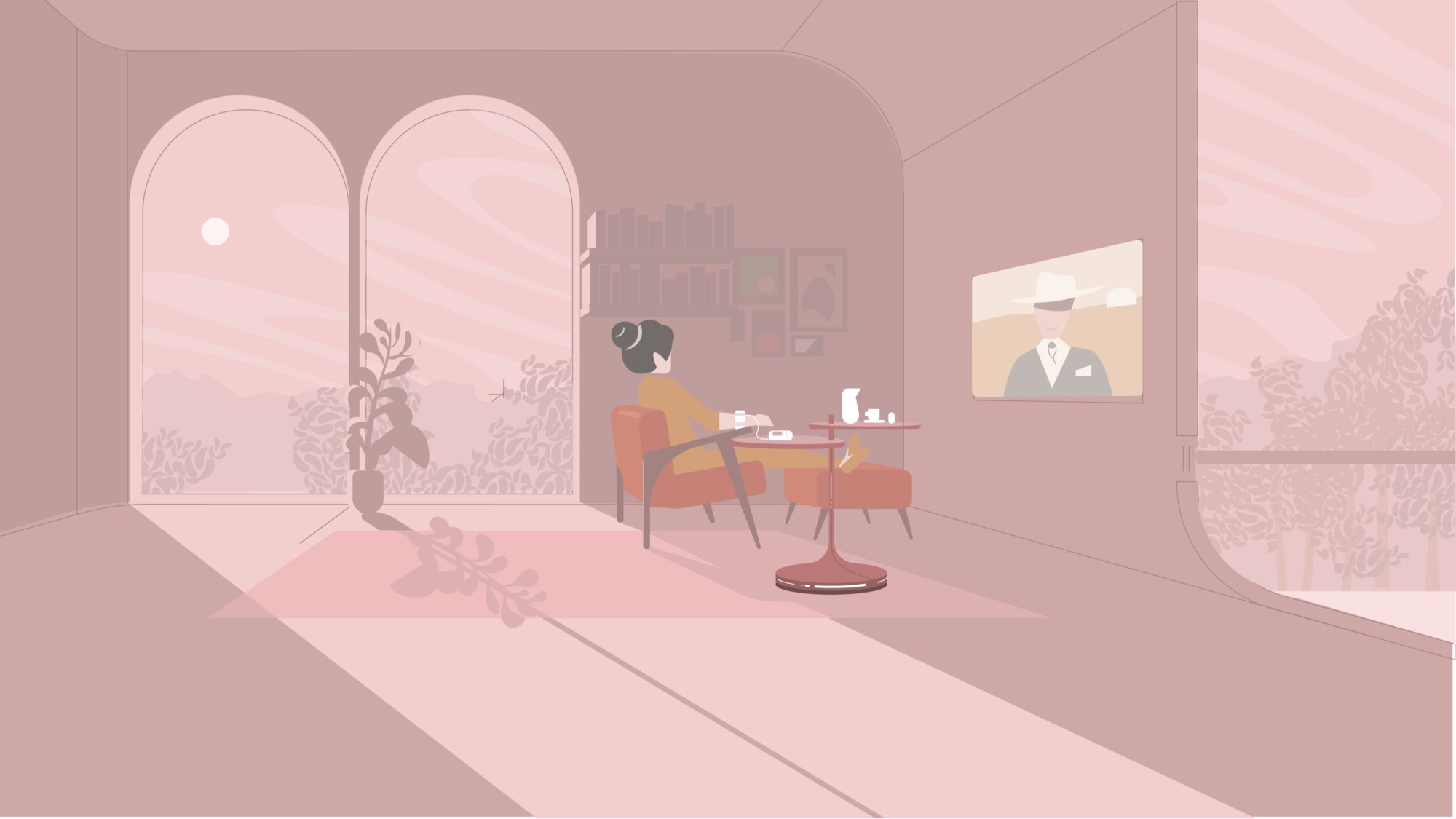
We often want to change our lives for the better, and forming new, more beneficial habits is a common way of doing so. On New Year’s Eve, millions say stuff like “Next year I’ll go to the gym on every weekday!” Or, following a scary discussion with their doctor, many will vow: “I’ll pay more attention to taking my hypertension meds regularly.” Then life happens… and the Doer in us slowly sabotages the grand schemes put together by the Planner. When picking up a new activity, at first it requires considerable energy to actually remember the task in question (which is often something that’s not fun at the moment but would yield great benefits in the future). Then, if you are persistent, a small miracle happens: for example, sitting down to meditate right after finishing work becomes easy, almost self-evident. You might even feel that something is wrong with your day if circumstances force you to skip it.
This is the power of habit: repeating a routine task doesn’t require you constantly pushing against your own nature. Now it has become an automatic part of your life. Even when you are in a state of mindlessness, it will be your default choice. So… is it possible to help people form habits? Absolutely.
Changing and building health habits with digital apps
Digital applications, especially mobile apps and smartwatches, provide ever-increasing potential for the healthcare industry to influence their patients’ health-related behaviour and habits. Developments of the past decade support this trend from two aspects: the advancing behavioural science and the omnipresence of digital technology serve as reliable and sturdy pillars to build things on.
On the one hand, theoretical models of habit formation are becoming ever more refined. On the other hand, extensive scientific literature is now available on Behaviour Change Techniques (BCTs) that provide practical methods to help people form more efficient health-related habits. Leveraging these techniques and understanding the science behind them, the tech industry has already turned recent findings to its advantage. The newly built, robust digital behavioural engines are now able to tie users to specific products and influence user behaviour on a massive scale. In fact, their effect is so powerful that controlling their influence on individuals and society has become a worldwide social challenge and has sparked intense political debate.
So, what is the scientific model behind habit formation? How can digital technology enable health tech companies to help patients form positive health-related habits? Let’s examine the science of how habits are formed and what major components are needed for a self-reinforcing cycle.
Components of the habit loop
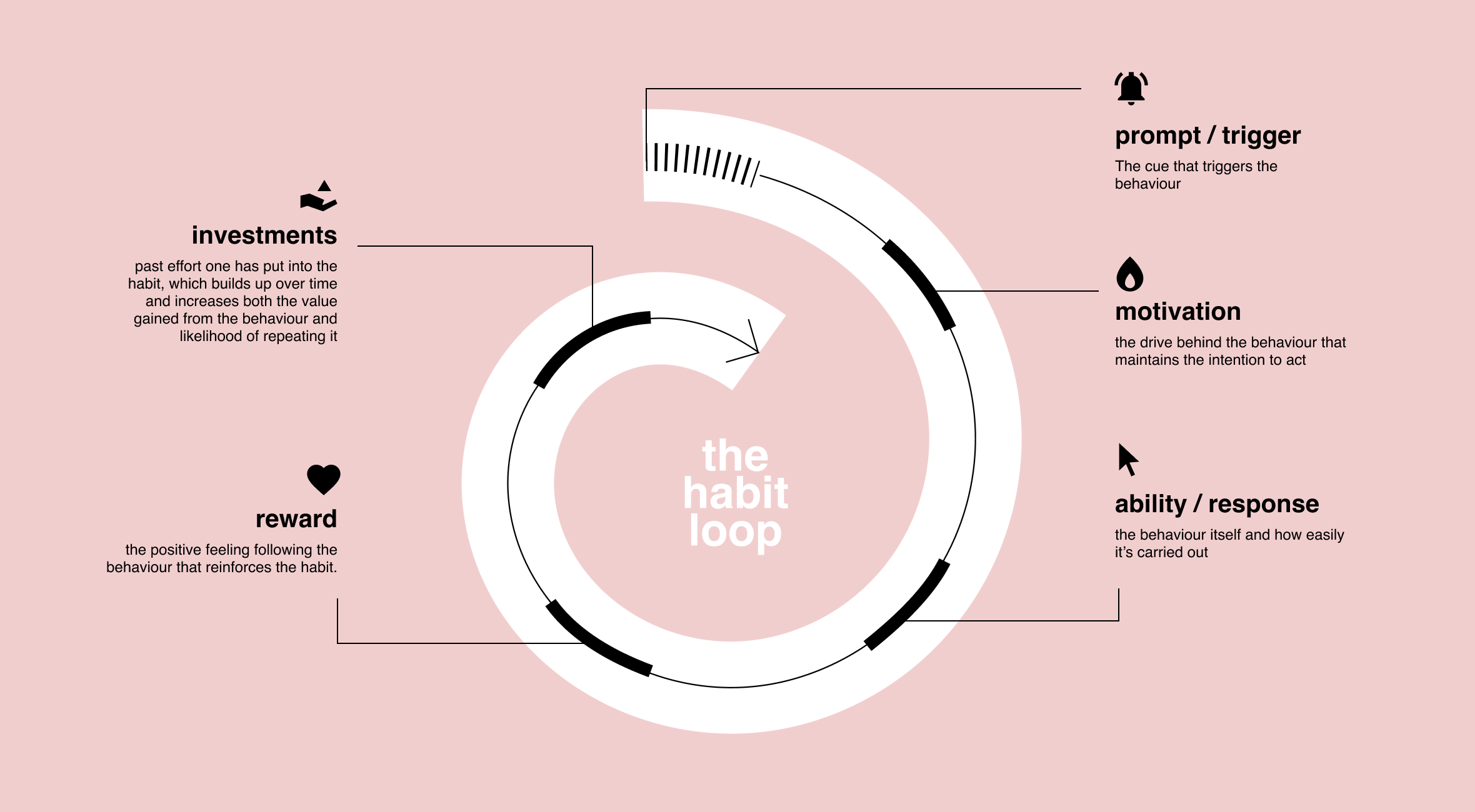
1. Prompt/trigger: The cue that triggers the behaviour.
2. Motivation: The drive behind the behaviour that maintains the intention to act.
3. Ability/response: The behaviour itself and how easily it’s carried out.
4. Reward: The positive feeling following the behaviour that reinforces the habit.
5. Investments: Past effort one has put into the habit. It builds up over time and increases both the value gained from the behaviour and likelihood of repeating it.
1. Prompt/trigger: the cue to start the habit loop
Every behaviour starts with a trigger that prompts it to happen in the first place. Without a trigger – whether it’s an internal feeling, such as hunger, or a cue coming from the environment, like a notification on your phone – the habit simply wouldn’t take place. So, the first step of creating or changing any health-related habit is to identify the trigger that can be associated with it.
Contextual prompts: find or create triggers in the environment
Most digital apps apply contextual prompts to trigger the expected behaviour. These can be artificially designed events like a push notification reminding you to take your medication at a certain time of the day. They can also be physical cues in your environment, such as keeping the medication on the kitchen counter where you’d spot it during breakfast.
Even though artificial prompts like push notifications seem to be the ultimate tool for digital apps to trigger behaviour, delivering them efficiently has become more and more challenging in the ever-increasing competition of digital noise. Even if received at the right time and place (using geo-location and machine learning for targeting), their impact is limited to the beginning of the habit formation. They lose their strength over time and quickly become part of the annoying digital noise we are all trying to block out anyway.
Action prompts: anchor to what they are already doing
To create a lasting change in one’s habits, we need reliable, long-term triggers that are deeply embedded in the person’s life. Triggers that are already there, and will likely persist in the long run (without our constant intervention). Professor B. J. Fogg calls these action prompts: one’s pre-existing habits that can serve as triggers to build new habits on.
The habit of flossing can be successfully connected to brushing your teeth – something that you reliably do every single day.
The key is to find an existing habit that matches the frequency and the physical location of the new habit and create an association between the two behaviours.
Digital apps are aiming to help users find the right anchor habits (pre-existing routines), then create and reinforce the association with the target behaviour. Notifications are a good start to kick off this connection, but the long-term strategy should be gradually substituting artificial prompts by solid action prompts, that is, habits strongly embedded in the user’s life. In other words: instead of sending reminders to people the same time every morning to take their meds, try to get them to keep their pills on the kitchen counter and take them along with their morning coffee.
2. Motivation: the fuel for action
Triggers are prerequisites, but on their own they aren’t sufficient to launch behaviour into action. The two other necessary components are motivation and the effort (or ability) to carry out the behaviour. Being reminded to wash your hands before eating is insufficient if there is no soap or disinfectant you can use, or you simply believe that “some dirt just makes you stronger anyways”. The key for digital apps is to recognise the inverse relationship between motivation and the effort required, as described by the Fogg Behavior Model (the original model uses “ability” instead of “effort”, which we changed for easier understanding). If it takes only a few seconds to scan your blood pressure data using an app, it’s much more likely that you will keep track of it – even if you’d lack sufficient motivation to meticulously record every result in a notebook and present it to your doctor. Inversely, if you happen to learn about a friend diagnosed with a serious illness, you might undertake extra effort to sign up for a thorough medical examination (one that you’ve been procrastinating for months).
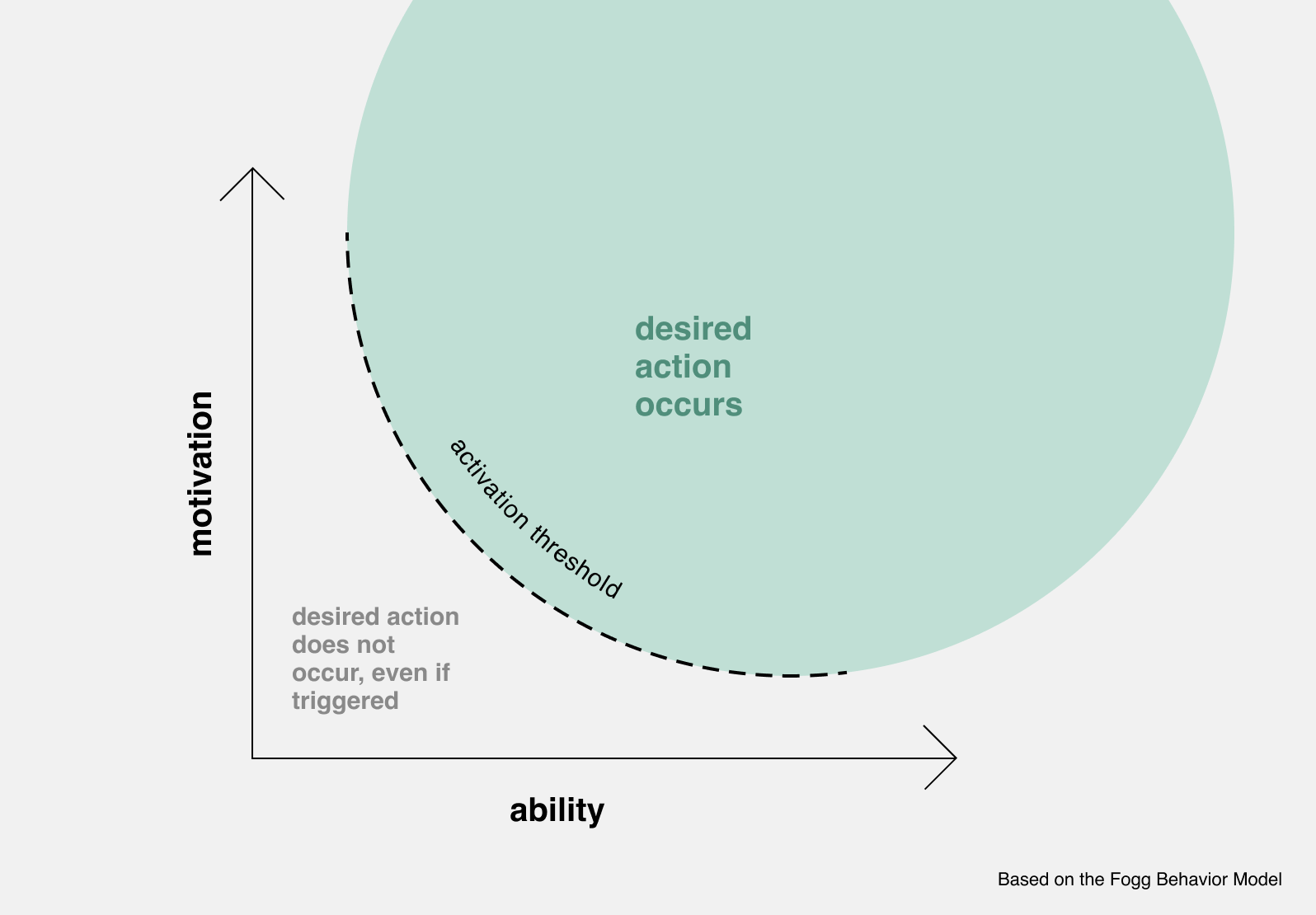
The strategy is clear: increase motivation and decrease the effort necessary to carry out the behaviour (or vice versa, if the goal is to put an end to a bad habit). In reality when designing habit-forming digital products it’s much more feasible to render beneficial behaviours easier for users than trying to influence their motivation to act. To a degree it’s possible to increase and maintain motivation through education and emotional design, but without initial buy-in from the customer, habit-building is not likely to happen.
We will look into the effort axis soon, but first let’s examine how motivation fuels habits and what techniques can digital health apps apply to boost it.
Motivational waves: use different strategies at peaks and valleys
A crucial aspect to consider when it comes to motivation is that it oscillates. You experience natural surges of motivation when you’re eager to change: you switch to a healthier diet, start exercising, or meditate every evening. In those periods (usually in the beginning of the year or after an important life event) you might even invest in a pair of new running shoes and go for a run a couple of times…
But then these peaks of motivation will inevitably be followed by valleys of motivational lapses. Different strategies are needed depending on whether the user is currently at the peak of a motivational wave or has slid down in a valley.
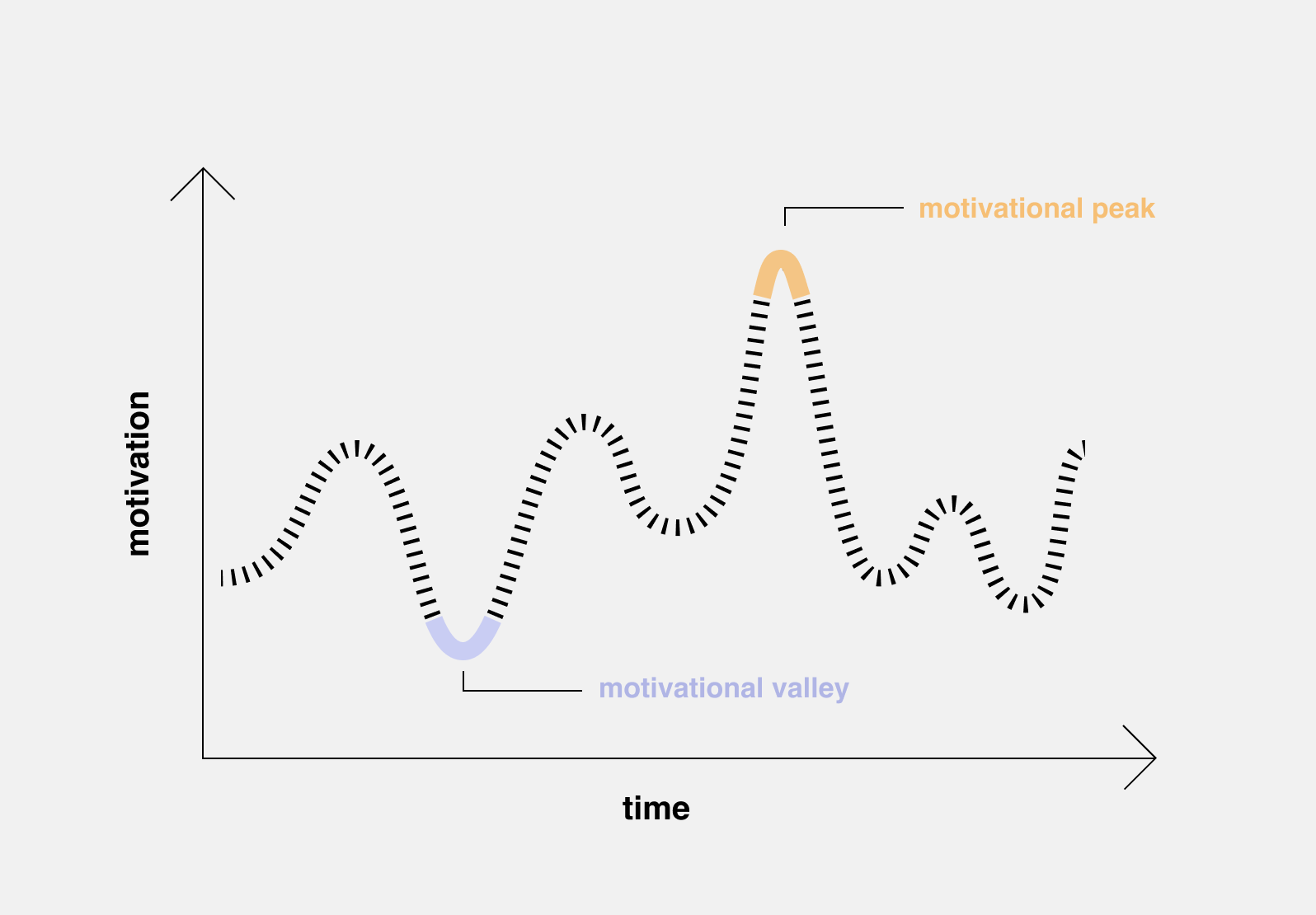
Motivational peaks are the best time to make users do the hard work that will help them stick with the habit in the future.
Get them to structure their future behaviour, create plans, goals, commitments to keep the new habit running. Do the investments to reduce any barriers that might hinder their behaviour in the future when motivation will be a scarce resource.
When motivation is low, concentrate on following existing structures, do baby steps, go for the small wins to keep the habit alive.
Users’ current motivational level can be assessed directly via quick survey questions within the app, or indirectly by analysing app usage.
As a general pattern with users, expect short periods of motivational peaks to be followed by longer motivational valleys.
Behaviour Change Techniques
There are several Behaviour Change Techniques (BCTs) that are designed to affect the motivational component of the habit loop. These are systematic procedures that can be employed directly in digital apps as active components of an intervention strategy. As always, there is no panacea that works for every user, so use these techniques as a source of inspiration to develop and test your own mix of methods that best fit the context of your domain and the characteristics of your users.
BCTs to boost motivation:
- Goals, challenges, tracking progress: Ask users to define their goals and let them track their progress visually. Beside long-term goals, offer tiny bits of challenges to keep the habit running. Motivation is fuelled by future results that we dream of reaching. Make sure your users don’t forget theirs!
- Temptation building: Connect the behaviour to a pleasant activity to make it more attractive.
(E.g., “Listen to a new podcast episode while doing your daily exercise!”) - Dynamic difficulty adjustment: Help users feel successful and competent by gradually adjusting the difficulty of their challenges.
- Anticipation of rewards: The benefits of a positive habit often lie in the future, but you can sweeten the deal in the present too if you include a little immediate reward. Provide material, emotional or social rewards for performing a behaviour or making progress with habit formation (points, price cuts, endorsements from friends, etc.). Keep rewards variable in their value to maintain excitement over time.
- Threats, loss-aversion: Remind users of the negative consequences of an unwanted behaviour or the possible loss it will eventuate. (Tread carefully: a light touch can work great, but you don’t want to create anxieties!)
- Social support: Connect users with friends and acquaintances to provide praise or emotional support for achieving their goal. Arrange a “buddy” whom they can turn to when they lose motivation or experience temptation for negative behaviour.
- Social comparison and competition: Build on the natural competitiveness of your users. Gamify the habit by making it a fun competition between friends who are working on developing the same habit.
- Streaks: Congratulate users on consecutive successful behaviour and use loss aversion to prevent breaking a positive streak.
- Achievements, badges: Name and visualise various achievements users have accomplished.
Identity association Depict the positive behaviour as part of the person’s identity (I’m a vegan, I’m a non-smoker). - Social commitments: Ask users to make explicit commitments in front of their social network and provide ways of accountability.
Find further ideas to boost motivation in the third part of our report focusing on Gamification.
3.Ability/response: do it with as little effort as possible
Start by making it easy
If there is one thing UX-driven digital technology truly excels in, it’s making complicated tasks easier for users. Scanning a barcode at a grocery store and getting actionable advice on how that food fits into your diet renders it much simpler to follow your recommended nutritional plan than having to investigate the ingredients and calculate their values on your own. The inverse relationship between motivation and the ability (the effort needed to do something) shows that reducing difficulty has strategic importance when users lack extensive motivation to perform the desired behaviour. Since motivation is much more difficult to control (and more prone to individual factors and oscillation), any habit-forming products first must ensure the simplicity of the behaviour by leveraging the latest technology and UX practices.
It is recommended to focus on making the desired behaviour as simple as possible before investing in interventions to increase motivation.
Luckily – unlike in the case of motivation – there are well-defined factors that determine what makes a behaviour easy to follow. There are countless ways how simplicity can manifest itself in a product, but at the end of the day they are all defined by the combination of a handful underlying elements.
What makes a behaviour difficult (or simple)?
a, Time
How long it takes to complete the desired behaviour. Or, to be precise, how long it feels that it would take. Ultimately, it’s the user’s perception that matters.
b, Physical effort
How much physical effort it takes to carry out a habit. Do I need to walk/commute to meet my doctor to discuss my medical data or can I share it from an app and book an online video appointment? Do I need to keep track of my blood pressure by noting it each time in my notebook or is it enough to scan my readings with my phone to have them memorised by an app?
c, Mental effort
The amount of cognitive load required to perform a behaviour. In most cases it takes substantially more mental effort to implement new, healthier habits than to follow clear treatment plans prescribed by a doctor. A frequent pain point experienced by patients is that their doctor is too busy to provide actionable advice on how to include the required changes in their everydays in a sustainable manner. Thus, they are left with having to figure it out on their own, or turn to less credible sources.
Part of the cognitive load comes from having to plan and reschedule daily activities. Further aggravating factors are having to remember to complete the behaviour (e.g., taking meds) and keeping track of necessary supplies (e.g., my pills are running out, I need to get a new prescription, etc.). With the advance of the internet, access to information is no longer an obstacle, but having to filter out relevant and trustworthy data and translating it to one’s personal context still adds to the mental load.
Digital apps can be effective tools to take over the overwhelming cognitive tasks that may hold us back from implementing healthier habits.
Providing a virtual coach or assistant is a widely used strategy in the health tech industry that aims to outsource the cognitive load from the user and mimic the benefits of a personal advisory relationship.
Virtual coaches help users:
- set realistic goals based on personal input;
- create implementation plans rooted in credible information;
- remind them to take action at the right moments;
- keep track of their progress and metrics.
Offering all the above with simple, comprehensive language and an intuitive interface is what allows this approach to effectively reduce cognitive difficulty in behavioural change.
d, Deviation from existing routines
The more a new behaviour disrupts existing routines, the harder it gets to implement it. The new habit might require reorganising several other related habits that are deeply embedded in one’s daily life.
Apps often fail in implementing new routines, as they might demand excessive changes far too quickly. People are simply unable to keep up. Transforming your diet, starting to exercise regularly, creating a healthier bedtime routine might interfere with dozens of your existing habits that you are unable to modify all at once (or even over the span of a few weeks or months).
For example, switching to a vegan diet requires you to change how frequently you eat, how you shop at the grocery store, how you cook for yourself and others, order meals, eat out, celebrate special events with friends/family, etc. And all of the above naturally comes with the inertia of decade-long routines holding you back from change.
If you want an effective strategy, target this problem at two fronts:
- Start with tiny steps (and leave giant leaps to astronauts): A popular method is to promote tiny first steps to kick off a habit and then gradually adjust the difficulty of the challenges and the amount of change required in users’ routines. Instead of trying to get someone to do yoga two times a week for 30 minutes, start with two-minute stretches that can be done after waking up – without requiring them to reorganise their entire morning routine. Two minutes to stretch? No excuses to skip that!Just one downward dog pose after stepping out of bed, then you can go and enjoy a well-deserved cup of coffee with the warm feeling of having completed your daily goal. The seed of the habit is there, and perhaps next week you can extend it to last for a few more minutes. Because you progress gradually, you have the time and the capacity to adjust other habits around it: start waking up earlier, prepare your breakfast the day before to leave more time for your expanding practice, etc.
- Attach to existing routines: Sowing the seeds of a new habit is extremely hard on barren soil. Instead of trying to build new habits from scratch, find a solid existing routine to which you can link the new behaviour. It’s a lot harder to add the routine of flossing at any random time of the day than doing it after brushing your teeth in the evening when you’re standing in front of the mirror anyway.
And remember: building on existing routines not only makes it easier to adopt new ones, but solid existing habits are the most reliable action prompts that can trigger the behaviour you want to cultivate.
4. Reward: positive emotions connected to your results
You have probably heard that the best way to reinforce a new habit is to give the person a tempting reward or a treat that will reaffirm the behaviour (and in turn makes them more likely to repeat it). Book a massage for the weekend if you have done your workout, receive bonus points in an app after taking your meds correctly, or get a delicious snack after completing your morning swim. After all, rewards are the final component of the habit loop that truly transform it into a self-reinforcing cycle!
Well, not so fast. What we usually call “rewards” (treats, candies, bonuses), are not reinforcing anything. Promising them to yourself could act as an incentive that provides the motivation to act and create the craving inside your brain to get it. But they are not the things that reinforce a behaviour. Gifts, bonus points and other incentives are often too far in the future to allow the brain to connect the dopamine shot one gets from receiving them to the behaviour that earned it.
What actually reaffirms a behaviour is the instant positive feeling you experience when dopamine is being released to your brain.
Instant positive emotions create habits, NOT cookies and treats
What truly reasserts and cements a behaviour is the sense of success, being proud of making progress, feeling competent, productive, admired and appreciated by others.
However, there is one major rule to remember: in order for these emotions to be associated with the behaviour, one needs to experience them during or immediately after completing the task at hand.
Imagine you decide to brave the elements and go for a run in the park, taking your favourite fitness tracking app with you. When you’re done with your usual 5K, you see that you finally managed to break your previous record. You also just passed the 100 km mark that year. You hear Roger Federer’s voice from the app praising your performance just as you cross the finish line. You feel proud of yourself, uplifted – you have reached a significant milestone! So, you go home with a satisfied, positive feeling, ready to go again later that week. Would you feel the same if the app hadn’t congratulated you immediately? Would receiving the same data as part of your performance report at the end of the month elicit the same emotion?
When designing rewards in the form of positive emotions, delivering them immediately after the behaviour is absolutely necessary for successful habit building.
Evoke positive feelings by celebrating success
Okay, we tackled the right timing, but here comes the next question: what positive emotions should we evoke to wire in new habits for our users? Even though what makes people experience positive feelings undoubtedly depends on individual factors, having users celebrate their success is an effective approach that you can safely build on.
You don’t need a glass of champagne to celebrate. Tiny positive affirmations included in the app can trigger users to feel successful on the way to developing a new habit. Here is a number of emotional design tools that you can apply in an app to create rewarding positive affirmations:
- Visualise progress: Progress bars or checkmarks on top of a daily to-do list will make user progress more tangible and help them appreciate even small wins like taking a pill or drinking a glass of water.
- Quantify results: Showing users the overall calories burned, miles run, number of hours spent with meditation helps translate abstract progress into concrete, tangible results that can be appreciated and shared with others. Progress that’s not quantifiable will stay invisible. Just make sure the results you show actually mean something to your users. If they don’t understand what 100 calories mean in their personal context, you either need to translate the information into something more relatable (like cookies) or include some education.
- Celebrate milestones: Breaking down hard to achieve, long-term goals into various smaller milestones will provide more opportunities for celebration and experiencing success.
- Promotions and badges: Being promoted to a higher level or tier in the app or getting a badge that acknowledges performance will make progress feel official and more appreciated. It will also remind users of their earlier success each time they open the application.
- Social reinforcement: There’s a reason why 86 million photos are posted on Instagram every single day, and that is the satisfactory feeling brought on by social reinforcement. Likes, comments, reactions by friends and others can act as extremely powerful emotional rewards. (Only check whether the context and the domain of your app is something users will want to share about themselves!)
5. Investments
Changing and building a habit is a long-term endeavour. It’s the experience of getting through the habit loop time after time that builds up and strengthens the new routine. The emergence of habit-building technologies has highlighted another element of the habit cycle: investments. Nir Eyal defines investments as consecutive effort one puts into a habit (and the product connected to it) that accumulates in the long run. Each occasion you invest effort in something makes you a bit more likely to proceed with that activity in the future. The more time and energy you put into reading about Mediterranian diet and figuring out recipes, the more likely you’ll stick with it. The more you play squash, the more skillful you get – which in turn makes you enjoy the game better and also provides higher confidence and satisfaction.
The human mind is naturally designed to stay persistent to a cause if you have already invested time and effort in it.
Let’s take a look at what lies behind this force and how we can leverage it for a habit-forming product.
More practice, better skills, more success
Investing your efforts in an activity will eventually make you more skillful in it. We have seen that the easier the activity, the less motivation you need to perform it. Putting effort into improving your skills even a tiny bit at the beginning of the journey will pay off exponentially in the long run. Video games and language teaching apps like Drops or Duolingo apply this principle perfectly: they urge users to invest their effort right from the start by having them practise with simple mini-tasks that improve their skills and make them feel successful at the same time. Again, the key is to start with tiny things, then dynamically adjust the difficulty of the challenge to keep users in the flow zone.
Escalation of commitment
A mental bias well known by social psychologists and sales reps alike: the memory of putting even a minuscule effort into something will magically open up the mental door for bigger commitment in the future. People like to stay consistent with their past selves, so investing time and energy into an activity at the beginning will become a driving force in itself toward larger-scale commitment. In other words: get users to begin with an activity and later remind them about their previous efforts, counting on their natural need of being consistent with their goals.
More usage, more data, more personalised experience
Digital technology provides another opportunity to amplify the effect of past efforts on future behaviour.
The more you use an app, the more it potentially knows about you – and the more valuable tool it will become in helping you develop positive habits.
Onboarding questionnaires will let the app create more precise action plans for its user, while collecting information about existing habits will help connect to better triggers.
How much value an application is able to offer is not defined solely by its built-in functionality. An app’s value increases constantly with usage (provided the product was designed to take advantage of it). A medication reminder app is more valuable if the user can rely on it entirely by having all their medication plans registered within the app. Storing years of your training data in a fitness app such as Strava will considerably raise the mental cost of switching to a competitor product.
Past usage generates triggers for future behaviour
The fact of using digital apps will on its own create data that contribute to forming triggers with which users are more likely to repeat the habit in the future. If a sleep tracker app gives you an analysis of your sleeping patterns from the night before, you’ll be more likely to remember to keep to the new bedtime routine you are developing. A smartwatch that offers data about your previous performance in the swimming pool will encourage you to push yourself even further next time you decide to go swimming.
In many cases, the simple act of involving digital products in your habit tracking can contribute to creating the right triggers to keep you in the habit-cycle.
Part III.
Gamification: motivate with the power of fun
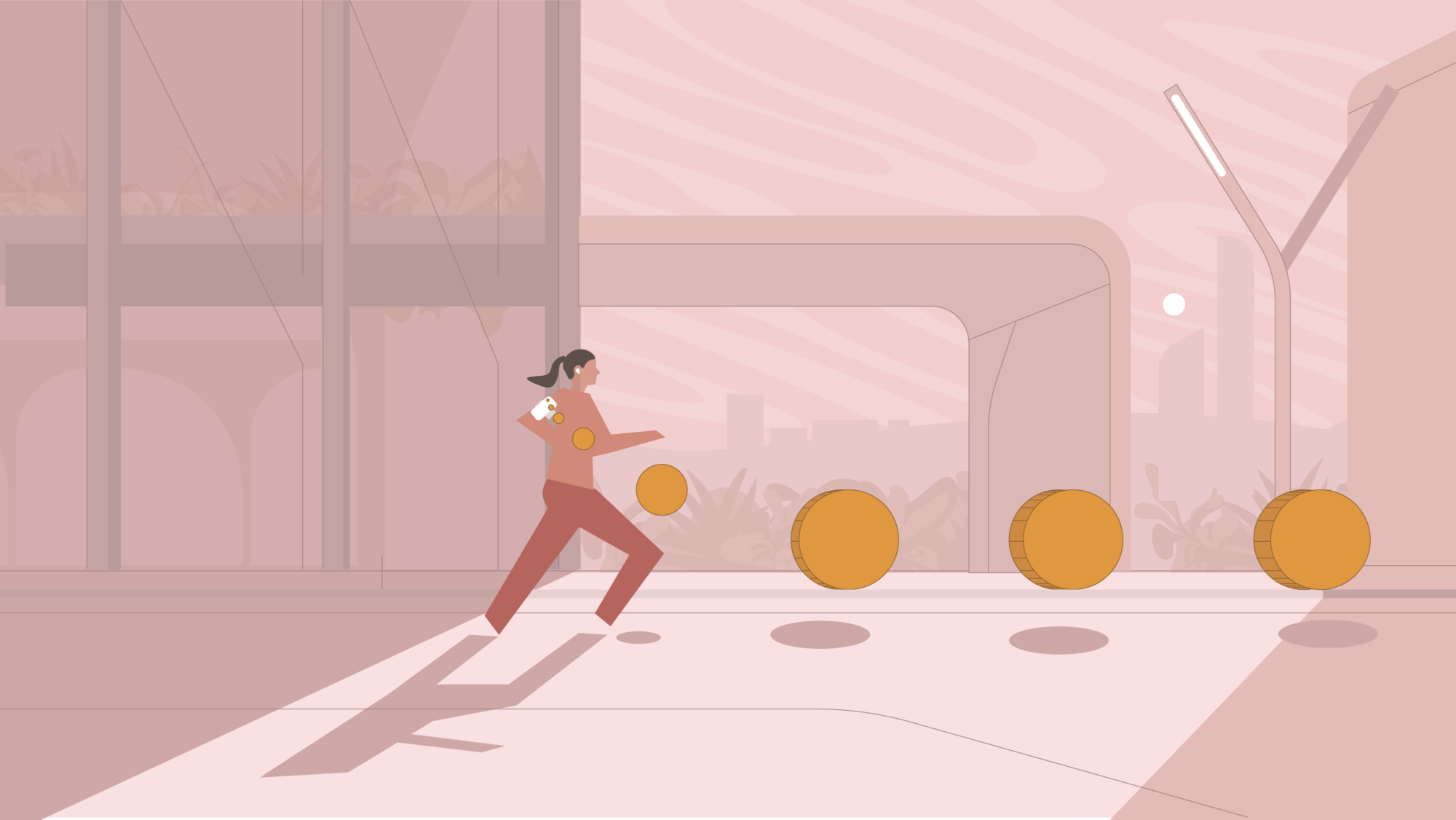
Today several ubiquitous health issues – such as high blood pressure or obesity – are rooted in our modern lifestyle. These conditions are inevitably linked to individual behaviour and habits like inactivity or chronic stress. Aiming to tackle these challenges, emerging digital products are supporting health behaviour changes and influencing people’s attitude in a positive manner. The main challenge when designing these products often lies with honouring beneficial behaviour with rewards that evoke positive emotions in the present – while the real health benefits will be manifesting only in the distant future. The situation is made even harder by the fact that while continuous energy investment (like sweating in the gym) is a very real experience, your future gain might be exactly the lack of a certain experience: as in, health issues caused by obesity.
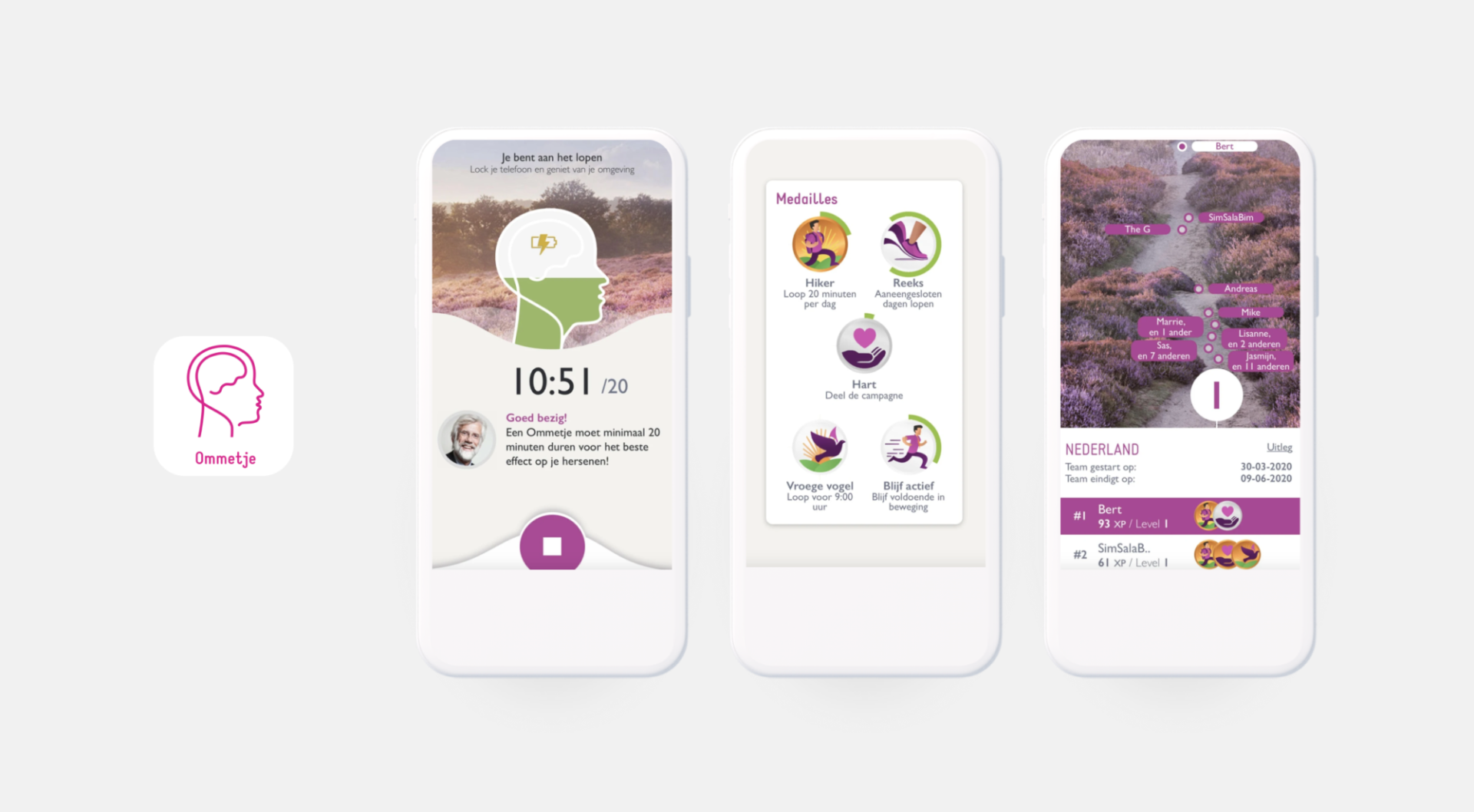
In plain words, the goal is to sweeten the pill of the required effort by creating “artificial” short-term rewards, as the real ones won’t manifest for a while (or noticeably, ever). In order to boost the level of engagement and help healthy habit-building, gamification is often used to reward the investment one puts into self-development.
The importance of gamification
The main goal of gamification in health products is trifold:
- Maintaining interest in activities deemed beneficial by health experts
- Adding rewards to healthy habit building loops;
- Fuelling motivation for continuous data collection.
Out of the above three, nowadays data collection is becoming increasingly important. Applications often serve as information funnels for health practitioners and AI engines to support prediction and prevention through pattern recognition.
Hopefully in the future most of the data will be automatically collected from wearables, but for now most solutions require active participation on the users’ side (adding another layer of significance to motivation management).
Moreover, in the field of mental health the majority of values can’t be measured directly and can only be understood through the subjective interpretation of the user, so for the foreseeable future these (at least) will be collected through self-reporting.
Prevention, diagnosis and treatment can all be redefined through data, but for that to work people need to consciously help collecting it – and gamification is a great tool to urge them to chip in.
How does gamification work?
The premise of gamification is an easy sell: playing is fun, work is less so – could we make work feel like a game?
The tricky thing about gamification is that it’s not possible to define it using a single underlying psychological mechanism. It means adding a “gameful experience” to an otherwise not game-y product. But games encompass a very wide variety of human activities, and recognising them more or less happens along the wisdom of “you’ll know it, when you see it”. If something feels like a game, then it’s a game.
The best definition for a game is that it’s a structured form of play that we do for amusement or fun. But following this statement, you will find yourself face to face with a mind-boggling amount of very distinct activities, as humans can derive amusement and fun from plenty of sources: socialisation, success, exploration, etc. (more on these later). But amusement and fun are key and – no matter which psychological mechanism you leverage to evoke them – they need to be the real dopamine fuelled-engine driving your gamification efforts.
Exactly because there are so many different games that can cause amusement, most gamification frameworks simply offer a toolbox of mechanisms that you can use to supercharge your product with fun. Then it’s up to you to mix and match the pieces in order to create a blend that works for your idiosyncratic user base.
Adding an extra layer of motivation to your product
We advocate for involving game design techniques and mechanisms in a non-game environment as it converts mundane tasks into fun and engaging activities, and encourages customers to use the product regularly. But it is important to see that products that expect gamification to fully replace missing user motivation rarely succeed with their mission. It’s best to think of gamification as an extra crutch that helps users limp through motivational valleys and sweetens the sacrifices required to reach their long-term goals. Primary user motivation can be created through overarching educational efforts that go beyond the domain of gamification.
Right, so what does this mean on a practical level?
When designing digital products, make sure you first align your value creation model with customers’ needs and motivations, then use gamification to enhance engagement and stickiness.
It’s also worth mentioning that gamification in excess (or if it’s not fitting the taste and needs of the user base) can easily reach the opposite effect: if you do it wrong, it can distract from the original goal and decrease the perceived seriousness of your product. Balance – and understanding your users through qualitative research – is paramount: while some apps successfully centre their whole experience around gamification (e.g., Duolingo), others use it as a slight incentive to motivate users without any sidetracking (e.g., Headspace meditation app).
Build your own gamification system that works for your users
We can’t emphasise enough that gamification systems always need to be built specifically for your product’s target group and context – there is no-one-size-fits-all stuff in gamification. On that note, just because your customers have similar health needs, you might still need to segment them further based on the motivators that work for them. In most cases, you will end up with a mix of various game mechanics that target different drives to ensure you have most of your users covered.
A bit confusing? Let us help! In the rest of our report we will showcase two gamification frameworks that can complement each other perfectly, and we will offer you a unified way to use them together as a practical design process.
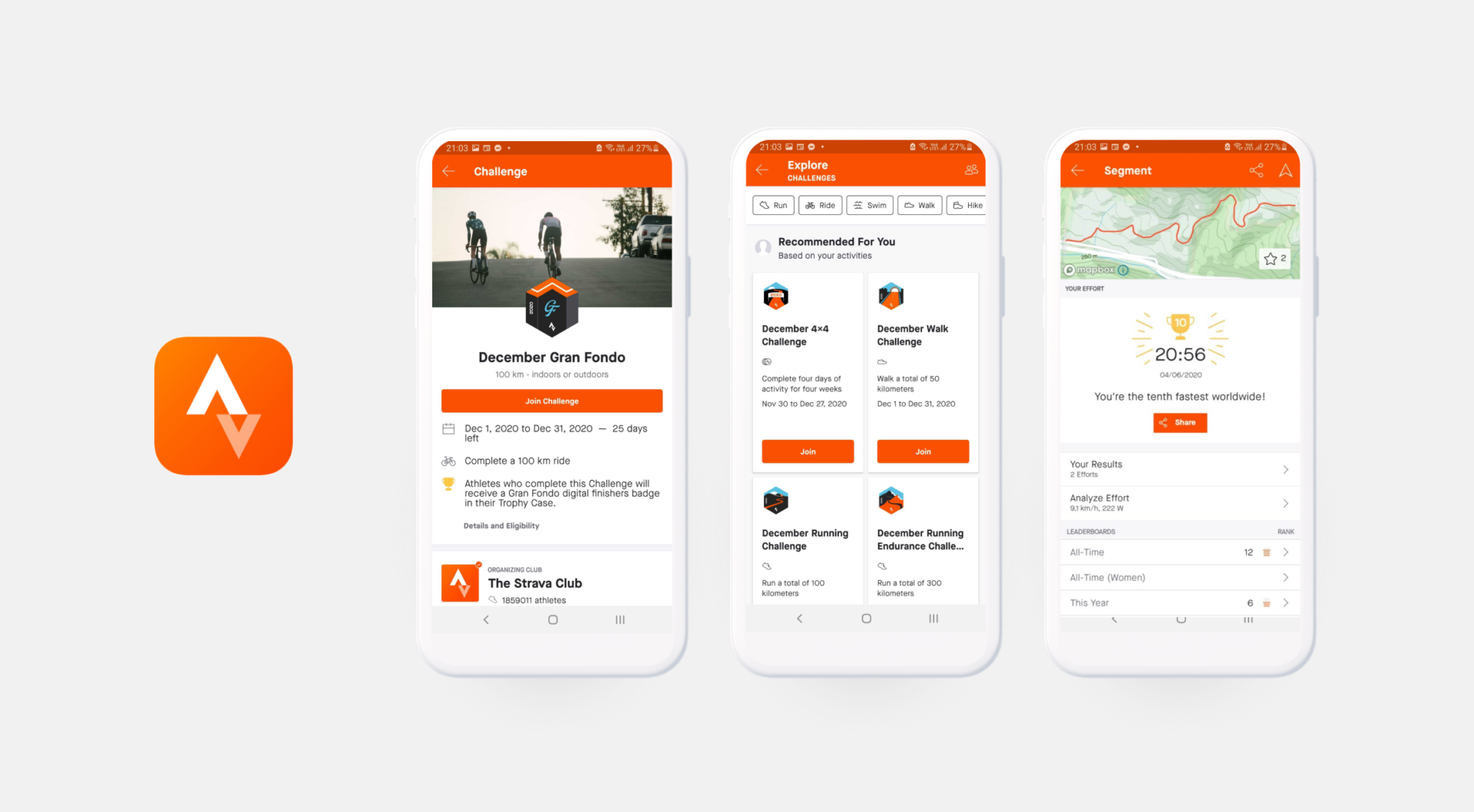
The Octalysis framework: the eight sides of human motivation
Gamification frameworks are useful tools to structure your design process and guide you to successfully connect drives with game mechanics. At Supercharge we found that the slightly arcane-sounding “Octalysis” model suited us best in our design praxis. Created by Yu-kai Chou in 2015, the framework has remained popular ever since as a big “a la carte” menu offering various components.
Aiming to systematically optimise human motivation, this model differentiates eight core drives that motivate users to perform certain activities. The Octalysis framework is visualised in the shape of an octagon, featuring core drives as the eight corners.
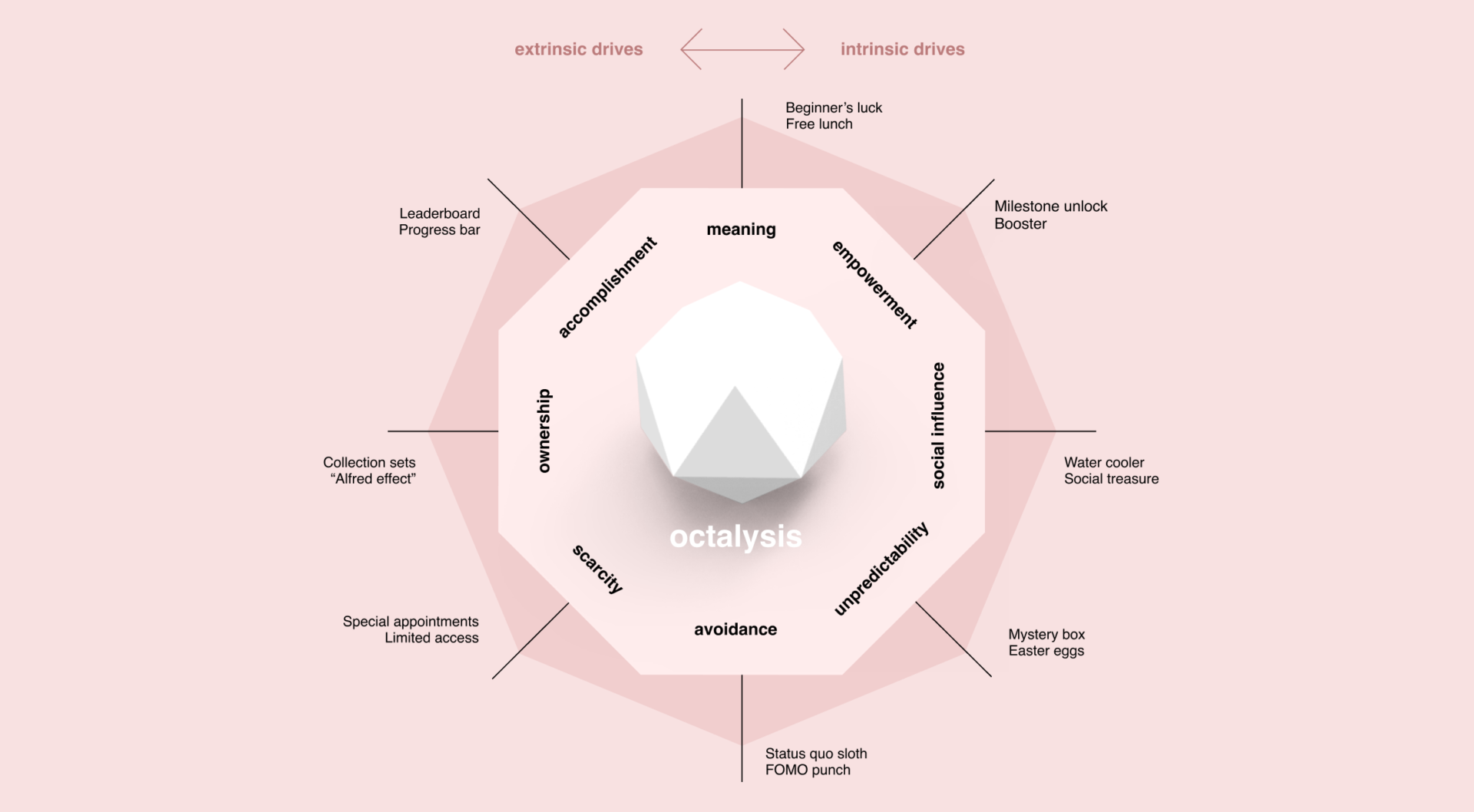
The drives on the right represent the creative, artistic, and social aspects of motivation, while the drives on the left side refer to the logical and intellectual aspects. The drives on the right side favour intrinsic motivation (fuelled by internal/emotional needs), while on the left they react well to extrinsic motivation (“rationally” seeking external rewards).
In our experience, businesses more often aspire to extrinsic customer motivation, offering them external rewards in return for achieving certain goals. True, this looks like a straightforward value exchange that has a certain appeal.
However, enabling participation in creative and social activities can build up mechanics that boost motivation in a much more sustainable way and make the activity itself gratifying.
Again, for the best effect we often need to blend multiple drives and build a potent cocktail that targets extrinsic and intrinsic motivators at the same time.
The drives on the bottom of the Octalysis diagram are categorised as “Black Hat Gamification”. These build on negative motivators, such as carrying out a certain action because of the fear of losing, or because the customer doesn’t know what will happen next. The drives on the top are labelled as “White Hat Gamification” and are considered as positive motivators. These aspects motivate users via creativity, making them feel powerful by creating a sense of control.
We want to stress that Black Hat drives are not “forbidden tools” at all, as they can be very motivating toward beneficial activities. Only they build on negative emotions that will give users a less uplifting feeling. But let’s not forget that many of the best games create amusement through a careful blend of uncertainty followed by accomplishments – there is no feeling of success without the fear of failure. It’s the balance between these elements that is vital for achieving the desired results.
The Mechanics-Dynamics-Emotions (MDE) framework: from game design to an actual experience
While Octalysis offers a large assortment of drive-game mechanics pairs and can be used to make sure the right motivators are targeted, the MDE framework helps us think in a structured way about how our gamification efforts will actually work in the hands of real users (and how that will advance our product goals).
This model guides designers to build functions in the form of mechanics, which turn into dynamics when the user interacts with them and provide emotions and experiences. It highlights the basic idea that we can lay down the rules of the game, but it will be the users who create their own experiences by engaging with them.
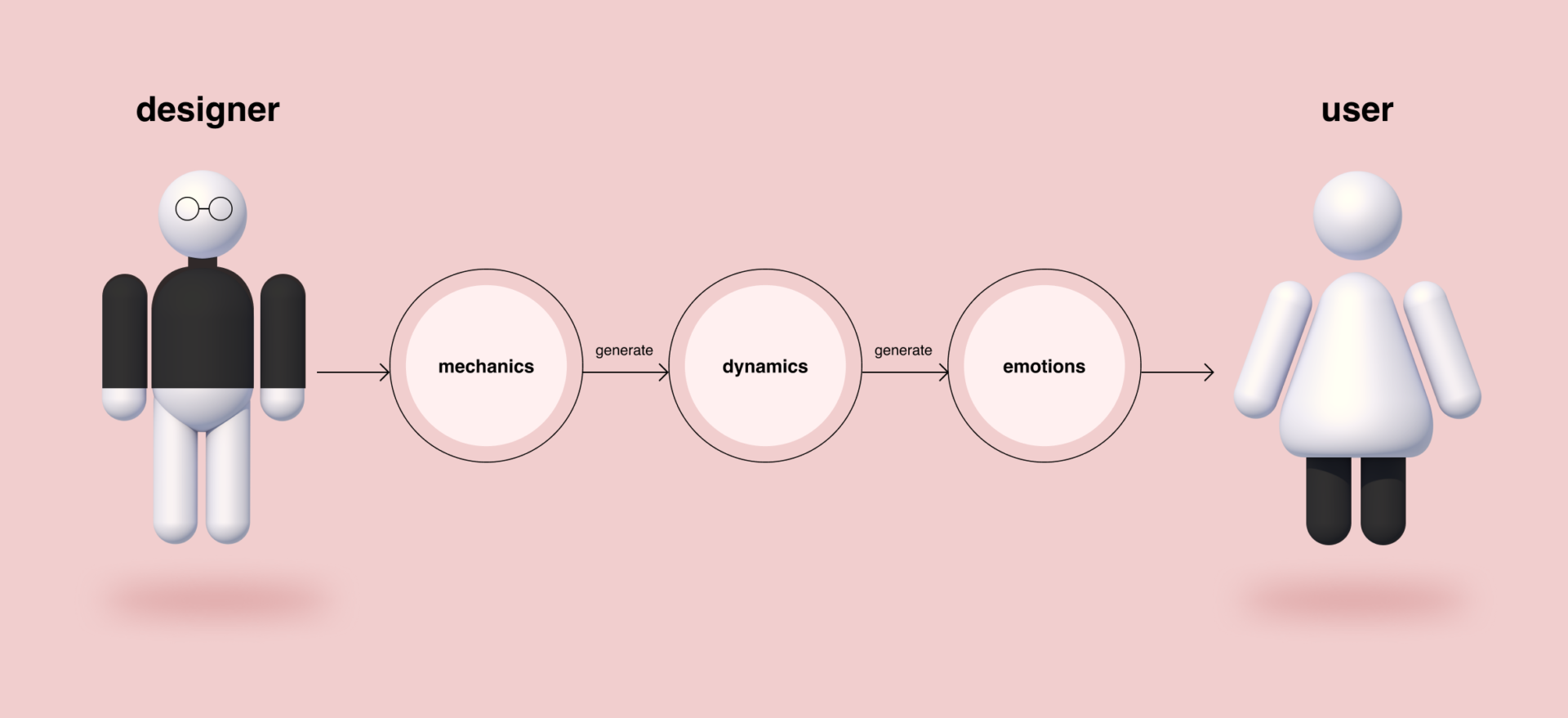
How to use the two models together to structure your gamification logic
We selected a handful drives from the Octalysis model that are best suited for health-related digital products and built a few examples utilising the MDE framework to better illuminate how it can be used to structure gamification efforts. If the above idea seems a bit theoretical don’t worry: the below tables will show you how to use the MDE logical chain in practice.
Octalysis drive: Epic meaning and calling
People are motivated because they feel they are engaged in something bigger than themselves (e.g., you are the only candidate who can save the world!).
| Game Mechanics | Dynamics | Emotions & sentiments evoked |
| Beginner’s luck: Distributing more rewards on the first use |
When on the very first day of using the app a user earns more points/coins than later, their journey starts on a high note which in turn motivates them to return. | Feeling special and appreciated, looking forward to more |
| Free lunch: Providing freebies for new users that would usually cost money/points later on |
The user gets a new avatar that is usually not free and it makes the reward feel especially valuable for them. | Feeling special and appreciated |
Octalysis drive: Accomplishment
People are driven by the sense of growth toward accomplishing a goal (e.g.: users receive a badge in an activity tracker application after every 10 km they run, officially acknowledging their success).
| Game Mechanics | Dynamics | Emotions & sentiments evoked |
| Leaderboard: A ranked list of users (or only the user’s own position) is shown based on their results. Depending on the goal, results can be filtered by several factors (e.g., all users, just the ones nearing the user’s results, location or social filtering…) |
Users performing a regular physical activity and tracking progress in order to improve a user’s rank on the leaderboard – do more to climb higher! | Feeling challenged; a sense success and growth; participating in a meaningful journey |
| Progress bar: A graphical representation often in a percentage format showing users how they are progressing with their tasks on their way to reach a certain goal |
A user meditates daily and gets instant feedback by being able to see their journey toward the next level | Participating in meaningful journey; a sense of progress, growth, control and clear orientation |
Octalysis drive: Ownership
When users own something, they want to nurture it, protect it and get more out of it (e.g., if you have invested a lot of time in an application constantly recording data about your preferred physical activities, you will feel that it’s uniquely yours).
| Game Mechanics | Dynamics | Emotions & sentiments evoked |
| Collection sets: Rewarding specific badges and items while showing what is still missing from the entire collection (and possibly offering extra benefits for collecting the full set) |
Giving users badges that are part of a special fitness activity theme (“The Runners Club”) drives them toward completing their collection. | Ownership, accomplishment, pride, preference for finished things, feeling invested |
| The “Alfred effect”: Constant customisation of the app based on users’ data, content and social interactions |
Users feel that an application is so personalised to their own needs that they simply can’t imagine using another service. | Ownership, feeling invested, familiarity, intimate relationship with the application, fear of loss (if considering switching to another application) |
Octalysis drive: Scarcity
People have a natural tendency to want things they cannot have because they are unable to obtain them immediately or it’s difficult to obtain them (e.g., limited edition items).
| Game Mechanics | Dynamics | Emotions & sentiments evoked |
| Special appointments: Specially dedicated time slots when extra rewards can be unlocked | Users need to report their morning mood right after waking up in order to gain extra rewards. | Feeling of accomplishment (when doing it on time), fear of missing out (when not) |
| Limited access: Limiting the length of user sessions through certain mechanics (e.g., energy points or simply time) |
Users are stopped from using the application and need to wait for their energy levels to be recharged before they are allowed to continue the journey – making them wait eagerly for the next opportunity. | Impatience, unavailability, eagerness, feeling that the time spent with the app is valuable |
Octalysis drive: Avoidance
This drive motivates through the fear of losing something or dealing with undesirable events (e.g., missing out on valuable perks if they don’t use the application or do the desired behaviour in a certain way).
| Game Mechanics | Dynamics | Emotions & sentiments evoked |
| Status quo sloth: Users are often heavily under-motivated to try new things or finish processes that require extra effort. We can design mechanics that keep the engagement alive to finish an important action (e.g., onboarding) |
“I’ll sign up tomorrow!” …but that will never happen. Let’s just stop for a moment: if you sign up right now you can start with an extra free meditation course! | Fear of missing out |
| FOMO punch: Showing users what they could have potentially acquired or what could they acquire if they won’t quit |
Users push themselves even harder to do better when they learn about how much they are “leaving on the table”. | Fear of missing out |
Octalysis drive: Unpredictability
Being blindfolded by uncertainty and anything involving chance creates strong psychological drives (e.g., a variable reward given to users after every action is a much stronger motivator than a fixed result).
| Game Mechanics | Dynamics | Emotions & sentiments evoked |
| Mystery box: Random rewards promised and given to users as expected once they have achieved a win-state |
If the user completes a five-day streak of measuring their daily mood they are promised a present – will it be something cool or valuable? You’ll surely get it, but you don’t know what is in it… Typically combined with collection sets for stronger effect. | Feeling of curiosity, surprise, hoping for value |
| Easter eggs: Surprise gifts given to users as unexpected rewards (preferably witty or funny ones) |
Unexpected gift for trying out a new feature, with some pun. | Feeling of curiosity and surprise, amusement |
Octalysis drive: Social influence and relatedness
Our activities are heavily influenced and inspired by what others think, do or say (e.g., mentorship, social treasures or envy).
| Game Mechanics | Dynamics | Emotions & sentiments evoked |
| Water cooler: Adding a forum/chat feature to your application where people can take a break from the main mechanics |
Users socialise with others, chat about the activity the product is built around and create lively discussions. | Feeling of fellowship, connectedness, community, joy of communication with like-minded people |
| Social treasure: Users can gift each other certain items within the ecosystem of the application, which often can’t be obtained in any other way |
Users give each other in-app tokens to help achieve goals (e.g., finish a collectible set), to motivate each other, or simply as a sign of appreciation. | Feeling of fellowship, gratitude (receiver), generosity (giver), connectedness, friendship |
Octalysis drive: Empowerment
A collection of various psychological drives, all connected to the feeling of empowerment. Showing users that thanks to their efforts and hard work they became more capable, or making them feel empowered by the outcomes of their own creativity.
| Game Mechanics | Dynamics | Emotions & sentiments evoked |
| Milestone unlock: When completing different breakthrough events, new features or reward types open in the app |
After runners reach the 100K mark within one month, new, more demanding challenge types are opened for the “pros”. | Feeling recognised for an achievement, accomplished, joy of mastery, feeling “elite” |
| Booster: Providing a unique ability/benefit to the user (within the application) that is only usable for a limited period |
Ensuring user empowerment for a limited amount of time (e.g., “In the next 5 minutes you’ll get triple points for any sprints!”). | Feeling empowered by your new-found superpower, taking advantage of the limited time opportunity, excitement, adrenaline |
A complex example targeting multiple drivers: Apple’s Activity and Health tracker
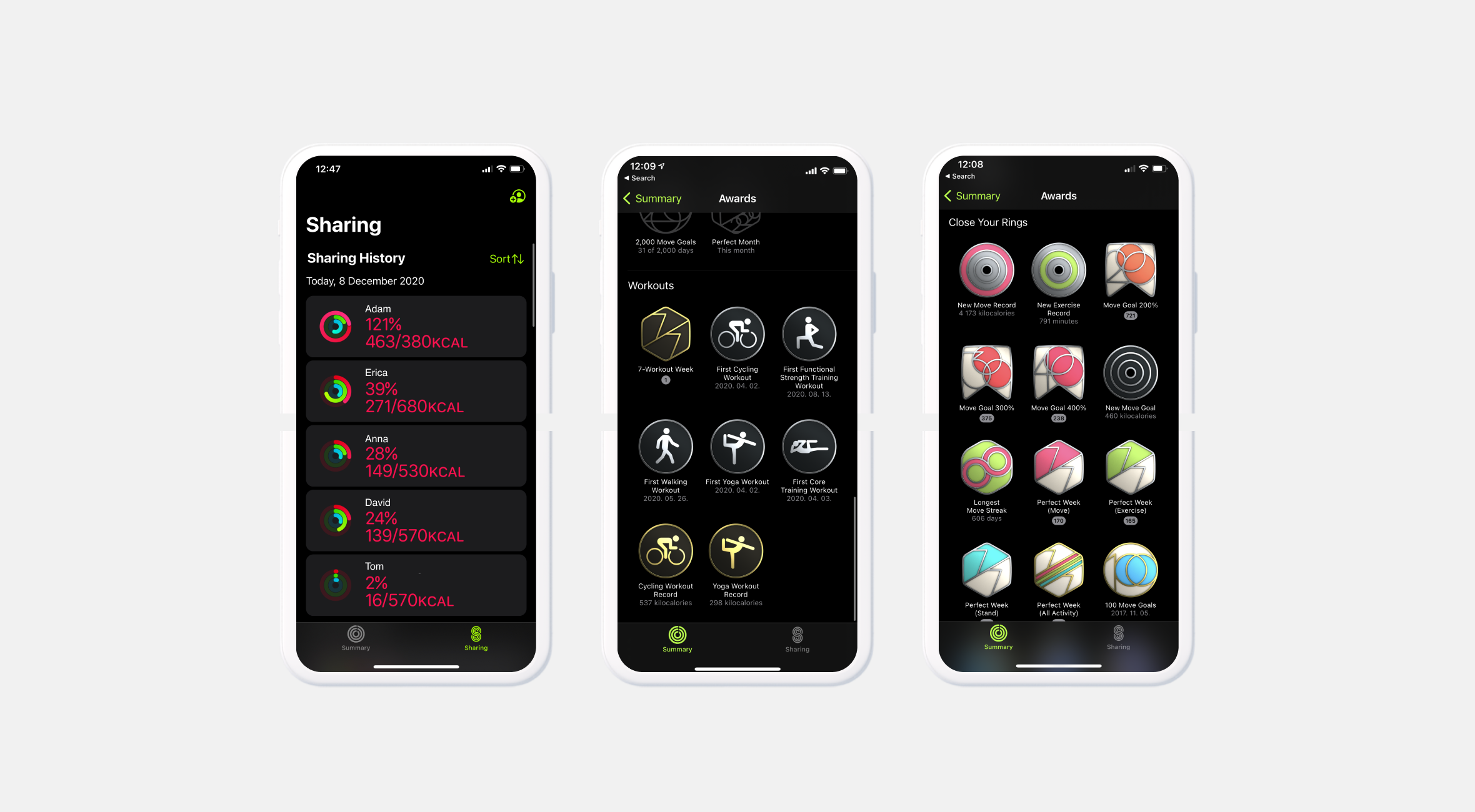
Let’s take a closer look at Apple’s Activity and Health tracker as a good example of a gamification experience that applies multiple mechanics. Anett, one of the authors of this report, uses it actively along with some other members of the Supercharge team. It allows them to check each other’s performance on HIIT classes, long-distance runs, and even during wild downhill bike rides in the snowy mountains, providing a leaderboard mechanic based on all the collected data.
They constantly feel challenged, it’s like a giant, shared obstacle course. The sense of fellowship is always present, since they are part of an active community. Badges that symbolise achievements can be collected continuously to provide a feeling of accomplishment.
Notifications offer instant feedback written in a fun yet motivating tone that has been empowering members even during the toughest early-morning runs. Social influence from other participants and the sense of relatedness comes naturally, because they are together in this whole challenge. And, of course, loss and avoidance also play a part in the overall motivation: none of them wants to be the last one on the leaderboard – they are all too competitive for that!

Rik Crutzen is a Professor of Behaviour Change and Technology at the Department of Health Promotion at Maastricht University. During our discussion on meaningful notifications, user context, and involvement, the professor highlighted three crucial challenges that need to be tackled today by emerging digital healthcare products.
First, leaderboards and gamified challenges are very powerful mechanics for individual goal-setting and their influence on motivation and engagement is clearly noticeable… in the short term. But the effect can fade away quickly. Sustaining it in the long run needs to be solved with more ingenious methods that fit well with the specific context of the product (remember, there is no one-size-fits-all solution!).
Prof. Crutzen also highlighted the power of just-in-time adaptive interventions. In practice this can mean hyper-targeted notifications and triggers, tailored to users’ exact context. The key is to define the perfect moment when people are open to being triggered to perform an activity (e.g., a reminder to measure their blood glucose levels or a little motivating push for an early-morning physical activity). As technology advances, there is ever more data to be collected regarding the context of each user, which enables increasingly precise targeting.
Finally – even in earlier phases such as problem-definition and ideation – the need to involve both target users and industry professionals is often underestimated when it comes to digital solutions. We wholeheartedly agree with Crutzen’s assessment: behavioural changes need to be supported by truly custom-made solutions, and continuous user research and testing is essential for touching on the right motivators. It’s also worth noting that testing such nuanced mechanics requires very complex prototypes that manage to render the experience personal and believable for customers. This is the only way to observe their efficacy in a tangible fashion.
Final Words: becoming more of a cyborg to become a healthier human
You are what you do, goes the age-old adage, and indeed a healthier self starts with healthier decisions and habits. The only problem is that our own nature is not always the best ally in our efforts to change for the better. So, we turn to technology to help us out in the endless chess match we play with our own nature.
Digital devices are our constant companions and we increasingly rely on them to augment our mental abilities in almost every area of life. It’s only logical that we also enlisted them to support our endeavour to become healthier and happier.
“Is there an app for that?” – contrary to popular belief, it isn’t just millennials and gen Z users who ask this question. Their parents and grandparents too are increasingly using their mobile phones as a natural extension of themselves. During the current pandemic even the most hard-line Luddites succumbed to the siren song of technology to finally see their grandchildren through the safe distance of video chatting.
And when it comes to health, it isn’t just patients who readily reach for digital solutions to track, support and improve their well-being. Changing customer expectations are relentlessly forcing health practitioners toward adopting new solutions, too. At the same time fresh opportunities opening through the constant stream of health tech innovation also push medical professionals in this direction. Naturally, practitioners too find their own everyday life made more comfortable by digitalisation, which influences their approach to digital tools in their practice as well.
We believe we are on the cusp of an era where it won’t be surprising for a psychiatrist to order some SSRI and a daily dosage of meditation app for chronic anxiety, and where lifelong medications will come with companion apps by default.
The trend of healthcare professionals embracing customer-facing health applications has already started in the Netherlands as well: the Luscii health tech app is increasingly used by doctors to reduce the number of required hospital visits. It enables remote self-reporting and offers meaningful in-app education for patients.
The new digital tools can do much more than support patients in their treatment or prevention efforts: their usage generates a treasure trove of data that enables an entirely new level of understanding for practitioners. This is supported by AI-driven pattern recognition solutions that speed up work for experts by providing insights instead of endless data streams, and pick up on irregularities hidden from the human eye. Millions of people constantly feeding their data into digital “memory banks” can lead to understanding systematic patterns at a level unparalleled in the history of medicine.
The key is to collect that data, which fortunately – thanks to an increasingly privacy-focused legislative approach – can only happen with patients’ consent and collaboration. Applications that enable this while also ensuring user engagement have a crucial significance.
Our experience shows that technology always needs to “become” human before we would adopt it en masse. Until designers figure out how to make a piece of tech fit our psyche, social life and daily routine without being intrusive and awkward, it remains nothing more than an interesting experiment.
And this is how we are all turning into cyborgs – technologically enhanced human beings – and not by transforming into the cold vision of sci-fi movies. We do it invisibly through interacting with friendly avatars on touch screens and fashionable wearables.
The next step for digital tools is to go beyond supporting physical behaviours: increasing our mental capabilities by nurturing better thinking behaviours with technology seems to be an exciting new frontier. Can it be done? For example, digital medicine company Akilli Interactive developed games that function as medicines. They utilise biosensors as well as game-like challenges and rewards to improve the concentration abilities of kids diagnosed with ADHD.
We sincerely hope that our report has given you a few ideas on how your product can shape human behaviour to help your users build their own healthier, happier tomorrow.
We are standing on the shoulders of giants. We used the following sources to create this report:
- Fogg, B. J. (2020). Tiny habits: the small changes that change everything. Boston: Houghton Mifflin Harcourt.
- Michie S, Richardson M, Johnston M, Abraham C, Francis J, Hardeman W, Eccles MP, Cane J, Wood CE. The behavior change technique taxonomy (v1) of 93 hierarchically clustered techniques: building an international consensus for the reporting of behavior change interventions. Ann Behav Med. 2013 Aug;46(1):81-95. doi: 10.1007/s12160-013-9486-6. PMID: 23512568.
- Eyal, N., & Hoover, R. (2014). Hooked: How to build habit-forming products. New York, New York: Portfolio/Penguin
- Thaler, R. H., & Sunstein, C. R. (2009). Nudge: improving decisions about health, wealth, and happiness. Rev. and expanded ed. New York: Penguin Books.
- Thaler, R.H. (2015). Misbehaving: The Making of Behavioral Economics, New York: W.W. Norton & Company
- Dawkins, R. (2006). The selfish gene. 30th anniversary ed. Oxford ; New York: Oxford University Press.
- Eagleman, D. (2015). The Brain: The Story of You. Knopf Doubleday Publishing Group.
- Pinker, S. (2009). How the Mind Works (1997/2009) (2009th ed.) . New York, NY: W. W. Norton & Company.
- Kahneman, D. (2011). Thinking, fast and slow. New York: Farrar, Straus and Giroux
- Youkaichou.com (2020): Yu-kai Chou: Gamification & Behavioral Design,
- Chou, Y. (2016). Actionable gamification : beyond points, badges, and leaderboards. Revised. Fremont (CA): Octalysis Group.
- Schmidt – Kraepelin et al (2019): Gamification in Health Behavior Change Support Systems – A Synthesis of Unintended Side Effects
- Landsell, J. – Hagglund, E. (2016): Towards a gamification framework: Limitations and opportunities when gamifying business processes


